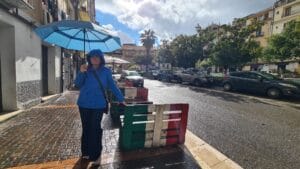
Lamezia Terme: The Blog That Nearly Didn’t Happen – By Andy
A2Z Wander | Our Blog A Rainy Arrival (and a Slight Hangover) Lamezia Terme almost didn’t get its own blog post. There’s only so many
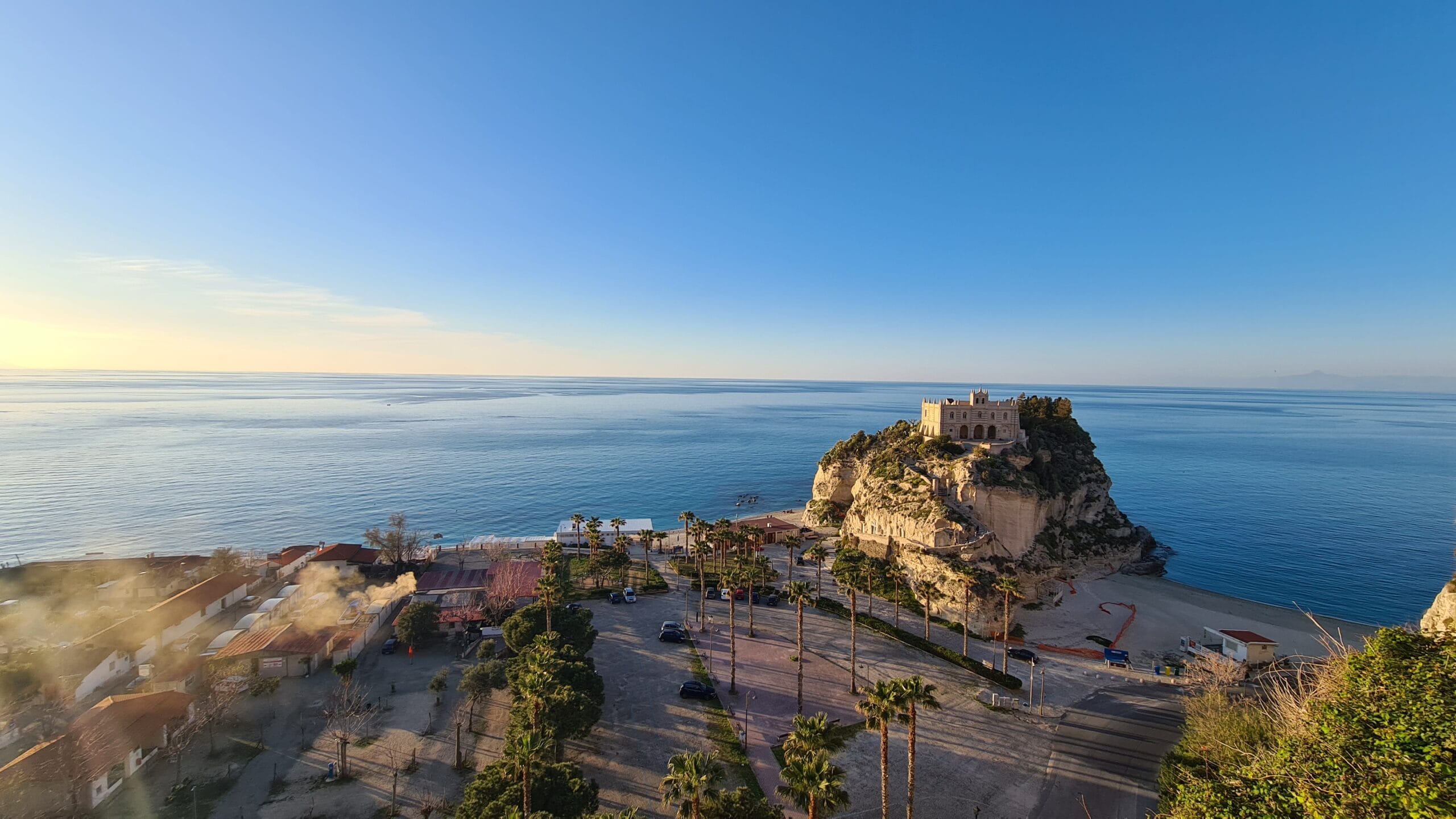
This is quite the introduction to the town of Tropea…
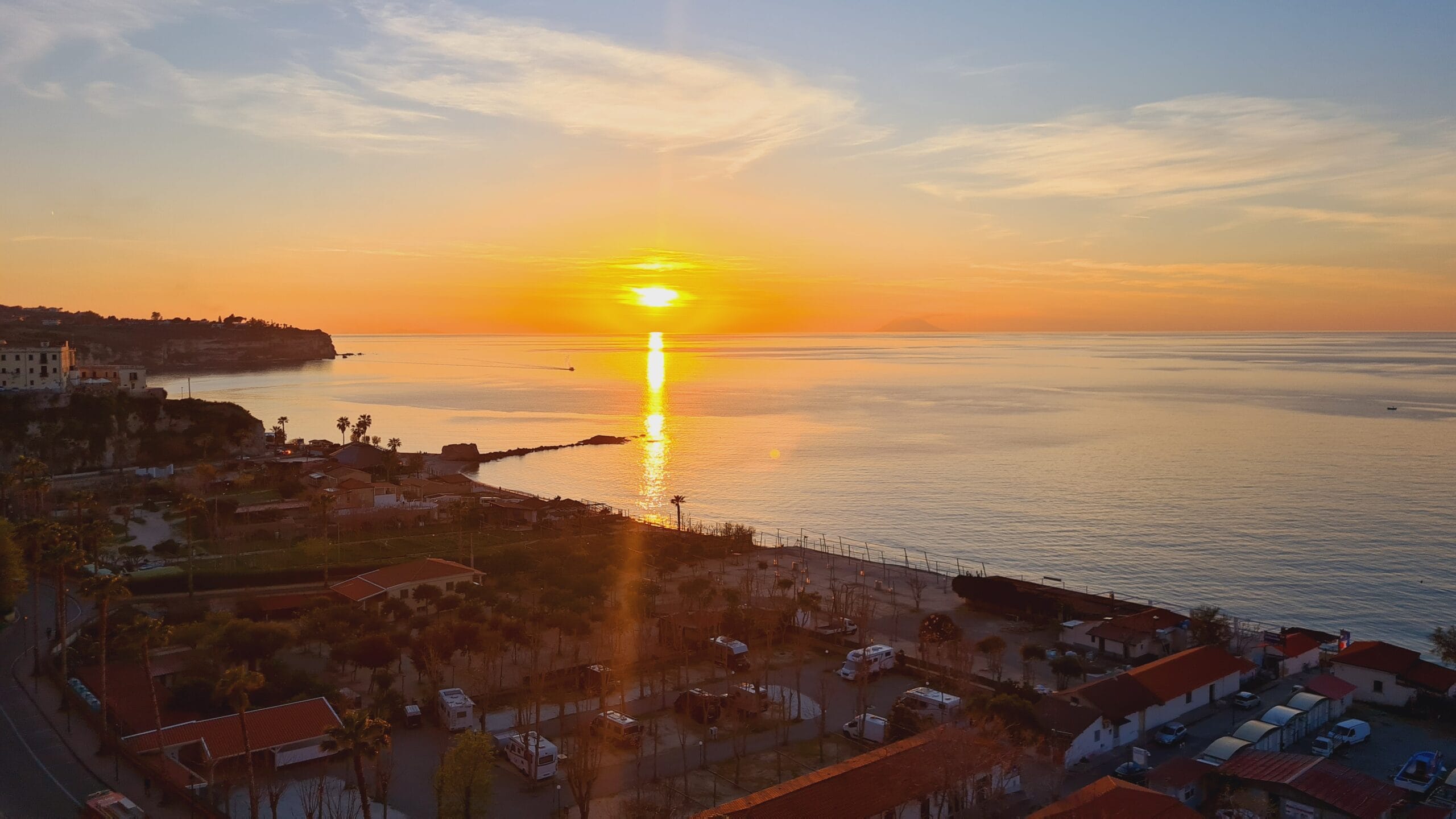
This is the view from Belvedere Piazza del Cannone in the old town of Tropea, the local meeting spot for sunset, and viewable from our apartment’s balcony, just a 30 second walk away. (Well done Zoe, another great booking!)
 But let’s rewind to how we got here – we were getting on a train in Salerno with four hours travel ahead of us, armed with little more than salad of stale bread, avocado and tomatoes for sustenance and a pack of bread sticks.
But let’s rewind to how we got here – we were getting on a train in Salerno with four hours travel ahead of us, armed with little more than salad of stale bread, avocado and tomatoes for sustenance and a pack of bread sticks.
Four hours is a long time to entertain yourselves, there’s only so many times you can pretend to be a walrus with breadsticks! Fortunately we’ve become quite adept at either using the time to make notes, write, or simply enjoy the incredible Italian countryside we pass through.
The train ride from Salerno to Tropea is fantastic, you hug the sea for large parts, getting so close you feel if only you could open the window, you’d be able to dip your hand in the Tyrrhenian Sea.
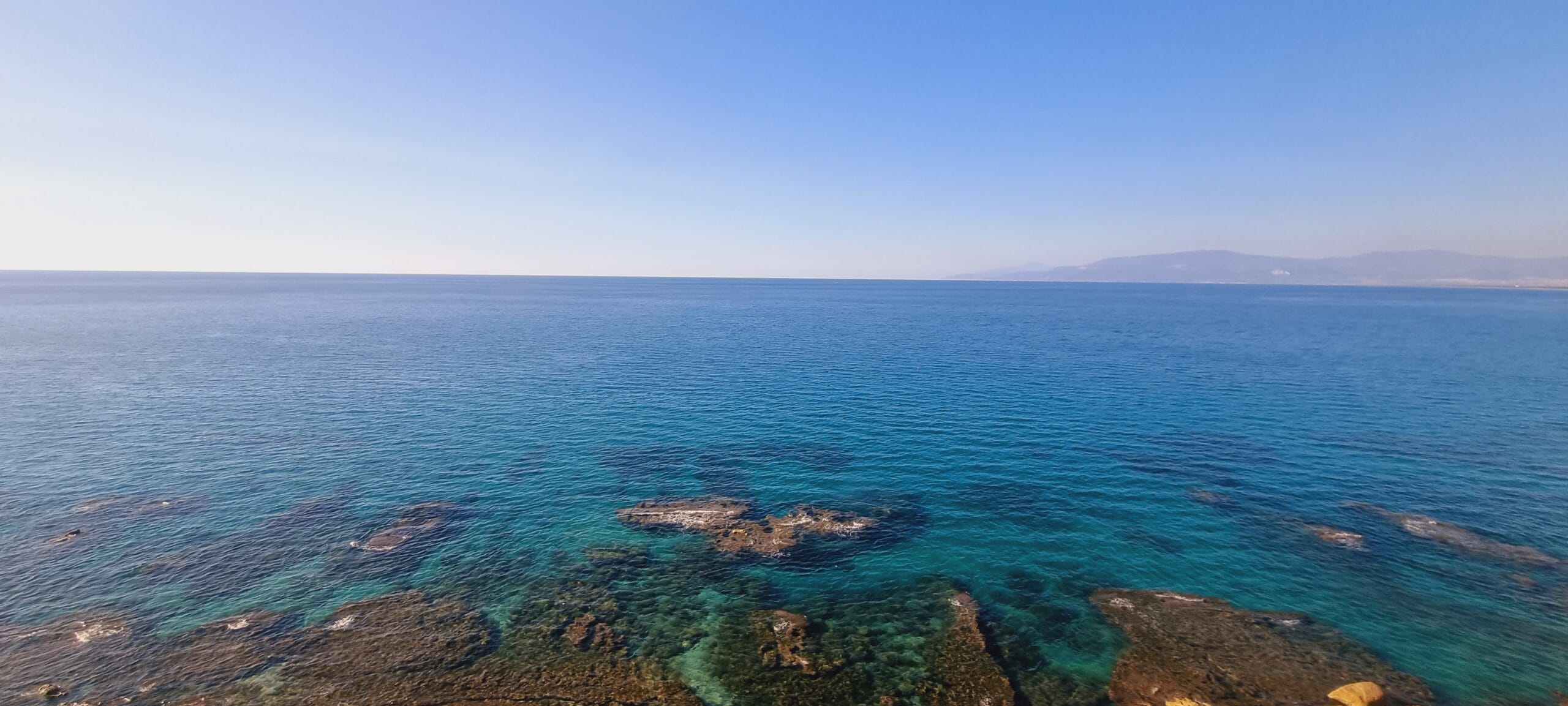
It was certainly one of our less productive journeys. And happily so.
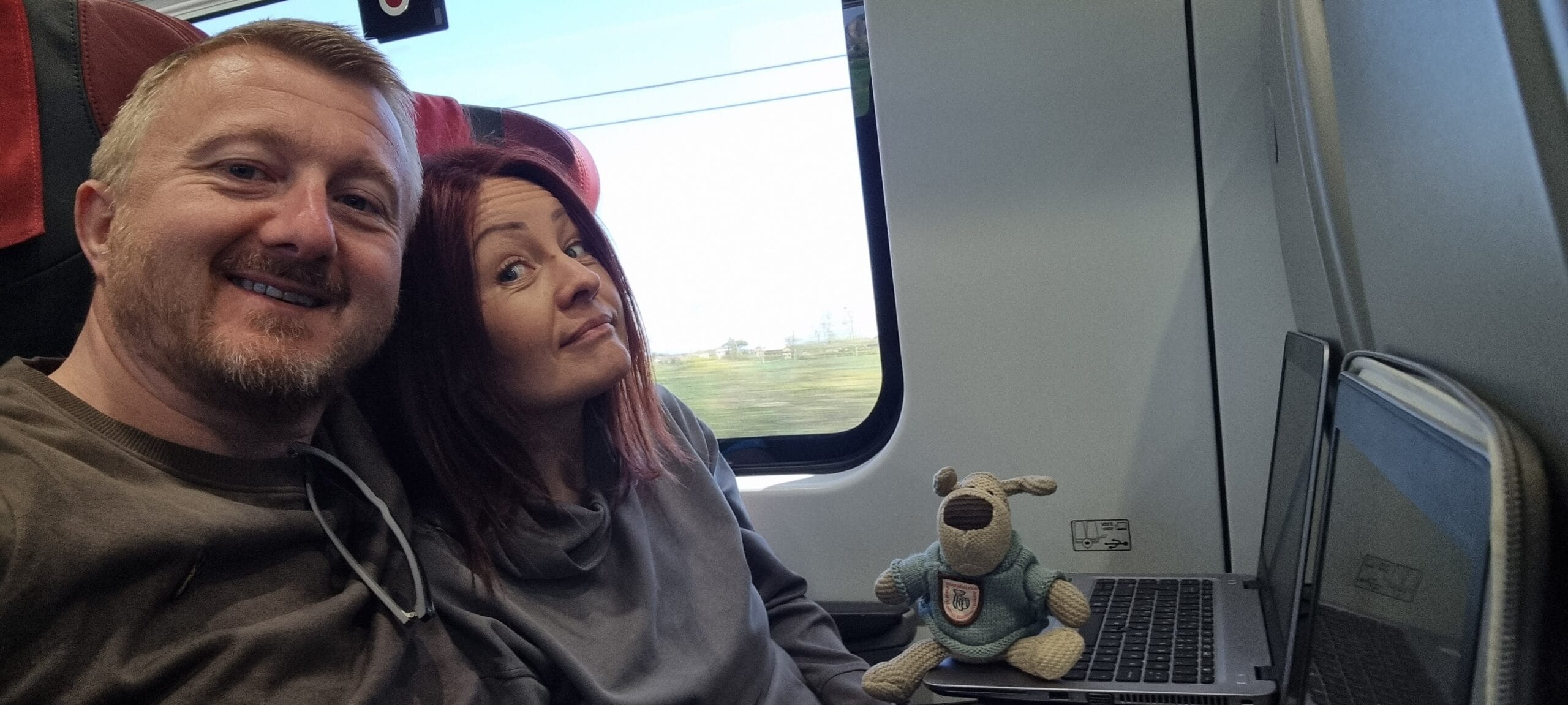
Back to the Belvedere… if Tropea had a VIP lounge, it would be Belvedere Piazza del Cannone. Tucked away near the historic centre, this scenic terrace offers the kind of views that make you pause mid-gelato, mouth agape (and not much makes me pause mid-gelato!).
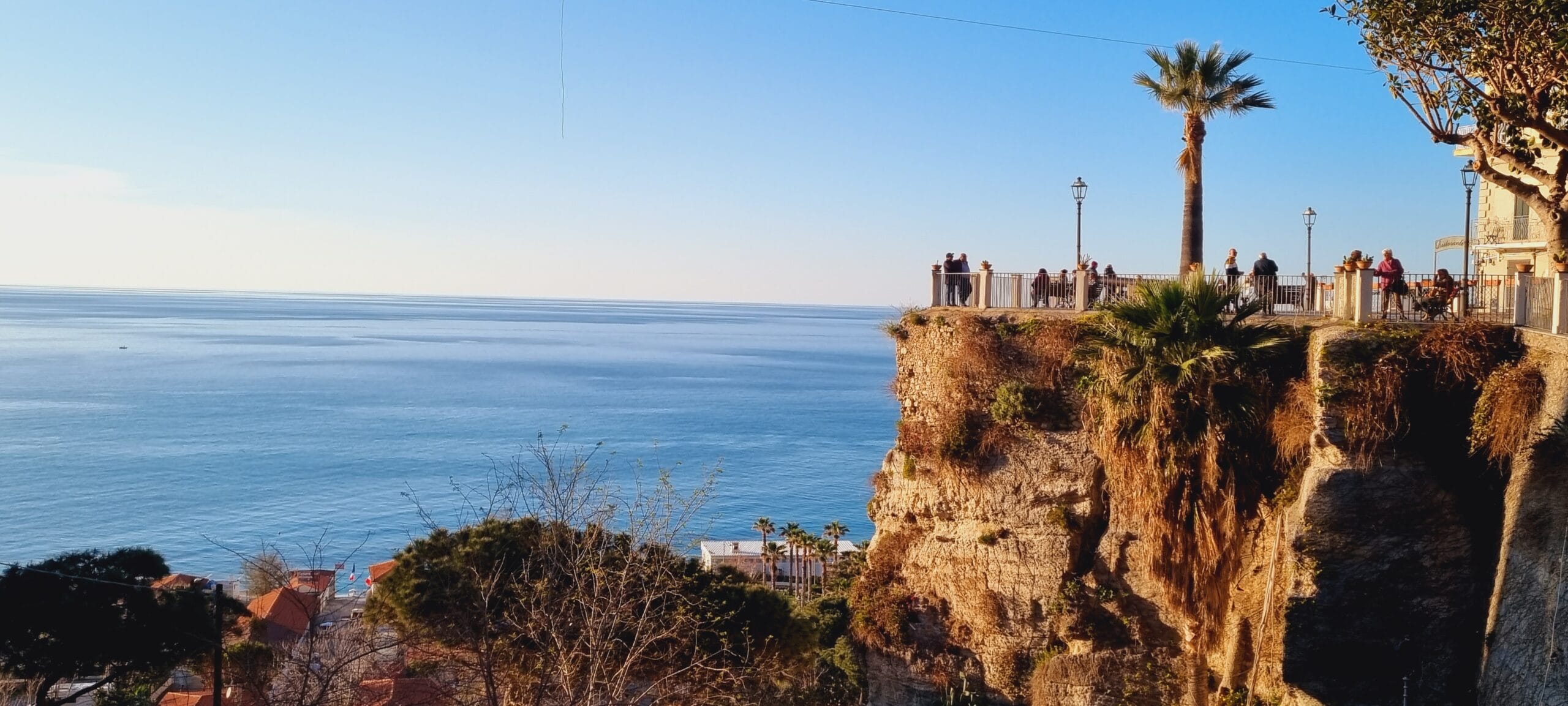
From this vantage point, the Sanctuary of Santa Maria dell’Isola stands proudly on its rocky perch, framed by the endless blue of the Tyrrhenian Sea. On clear days, the Aeolian Islands, including the smoking silhouette of Stromboli, peek out on the horizon, adding a dash of drama to the already cinematic scene.
The square gets its name from the historic cannon (cannone) that once guarded Tropea’s shores—a nod to the town’s storied past. Today, it’s more about capturing the perfect sunset shot than fending off invaders.
Benches line the piazza, inviting you to sit and soak in the panorama. The benches are a favourite spot for locals, and you’ll find visitors jostling for a view at the railings, especially as the sun starts its descent below the horizon, casting golden hues over the sea.
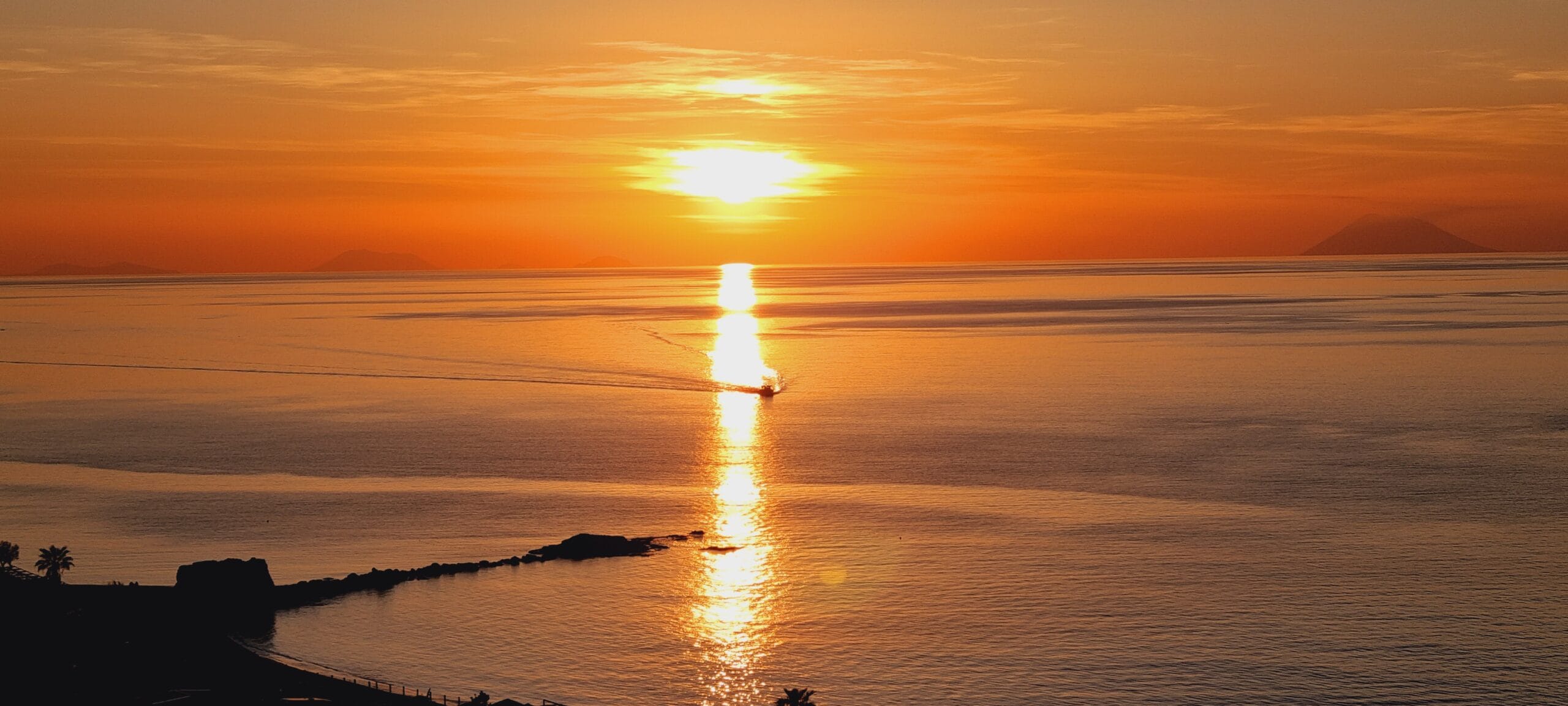
In a town brimming with picturesque spots, Belvedere Piazza del Cannone holds its own as a must-visit. Whether you’re an avid photographer or simply someone who appreciates a good view, this terrace delivers.
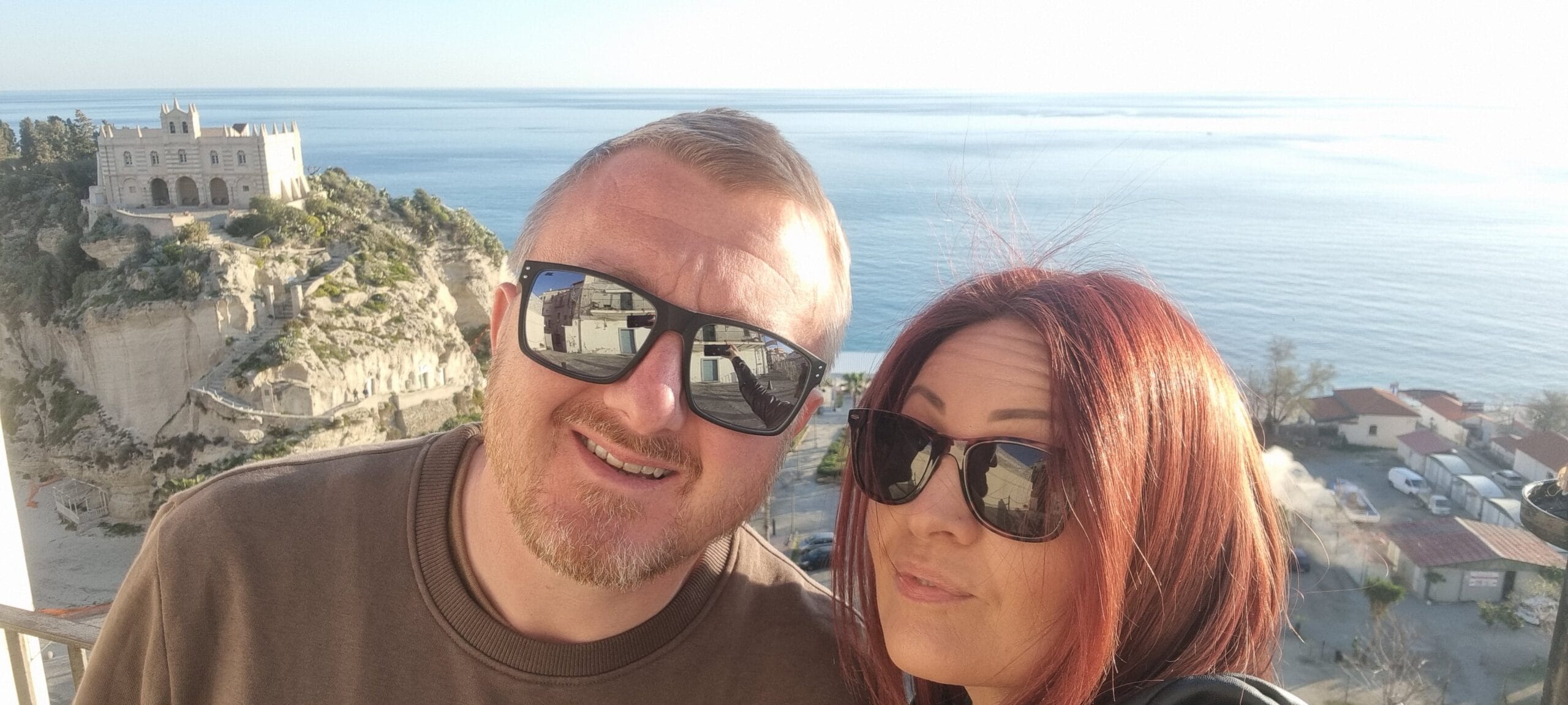
You know those places that seem like they were designed with a drone in mind? Santa Maria dell’Isola is one of them. (see this footage on facebook)
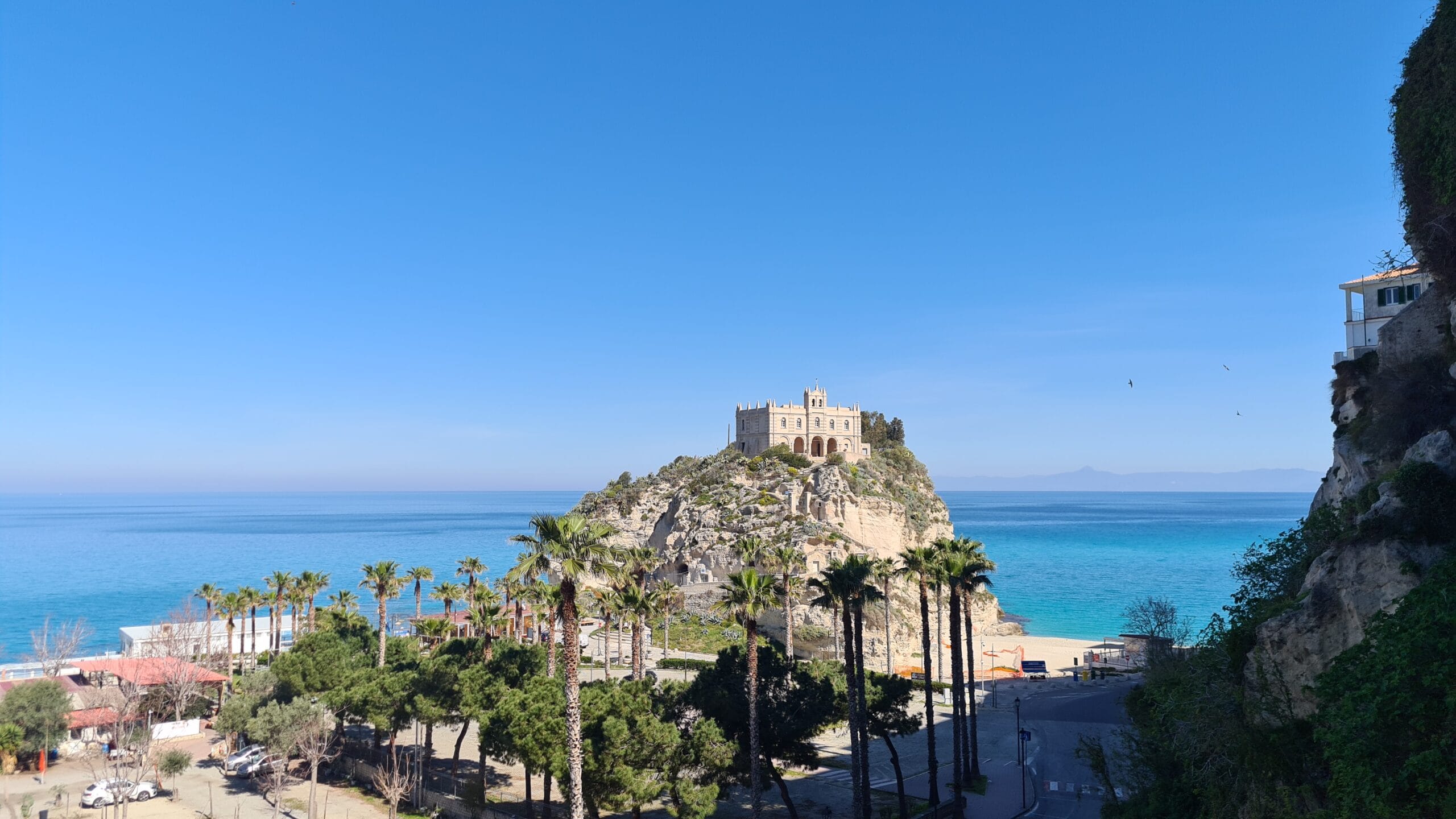
Perched dramatically on a rocky outcrop just below Tropea’s old town, this monastery is the centrepiece of just about every postcard, fridge magnet, and tourist’s photo collection taken along the Costa degli Dei—and for good reason. With the cliffs, the beach below, and the Tyrrhenian Sea glittering all around, it’s hard to believe it’s real.
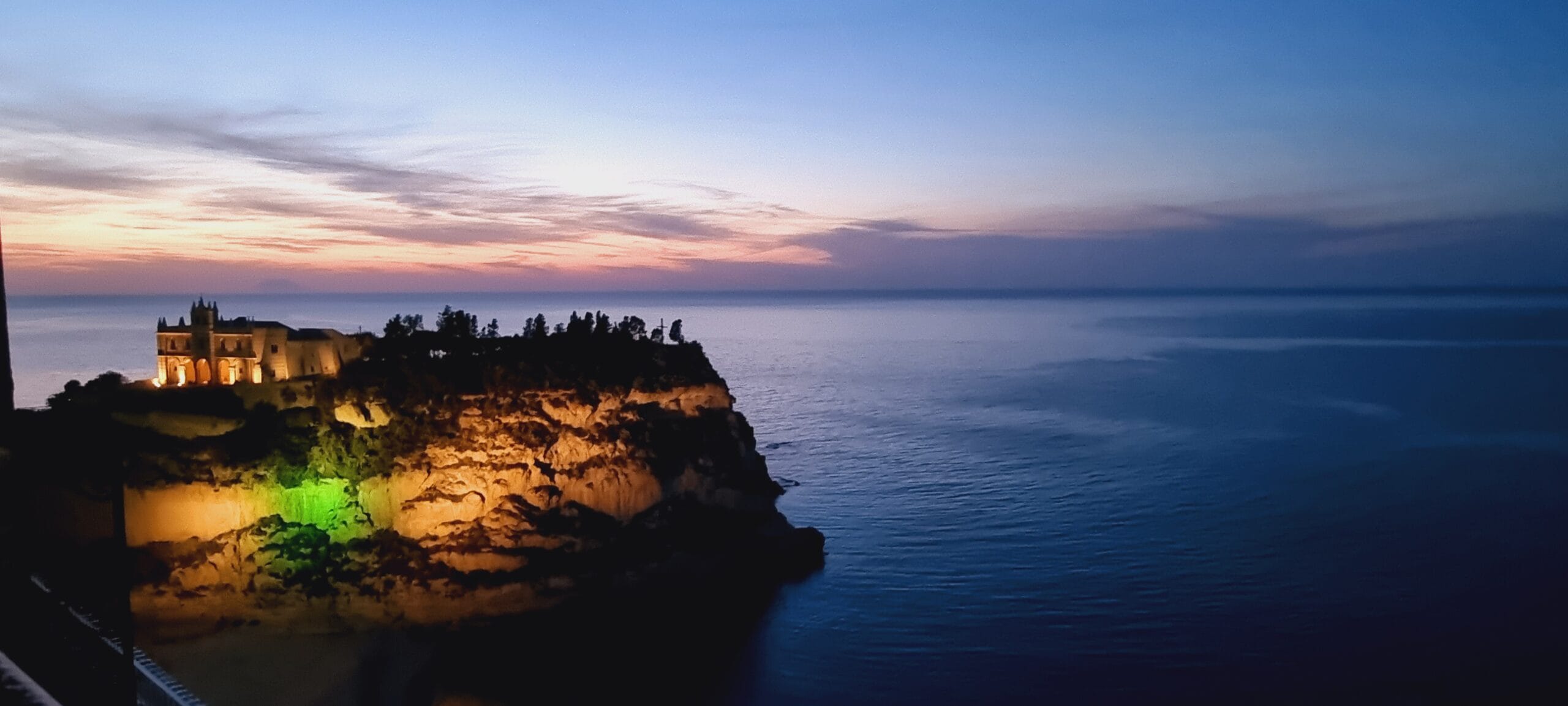
Unfortunately, we weren’t actually able to go inside, it was closed for some refurbishment work. But honestly? Even from the outside, it was majestic.
We climbed the steps up to the gate of the monastery. From there, we got a good panoramic view back at the old town—its pastel buildings stacked like a game of architectural Jenga. It’s one of the few spots where you truly feel the full drama of Tropea’s geography: a town carved into cliffs, surrounded by water, and watched over by this incredible monastery.
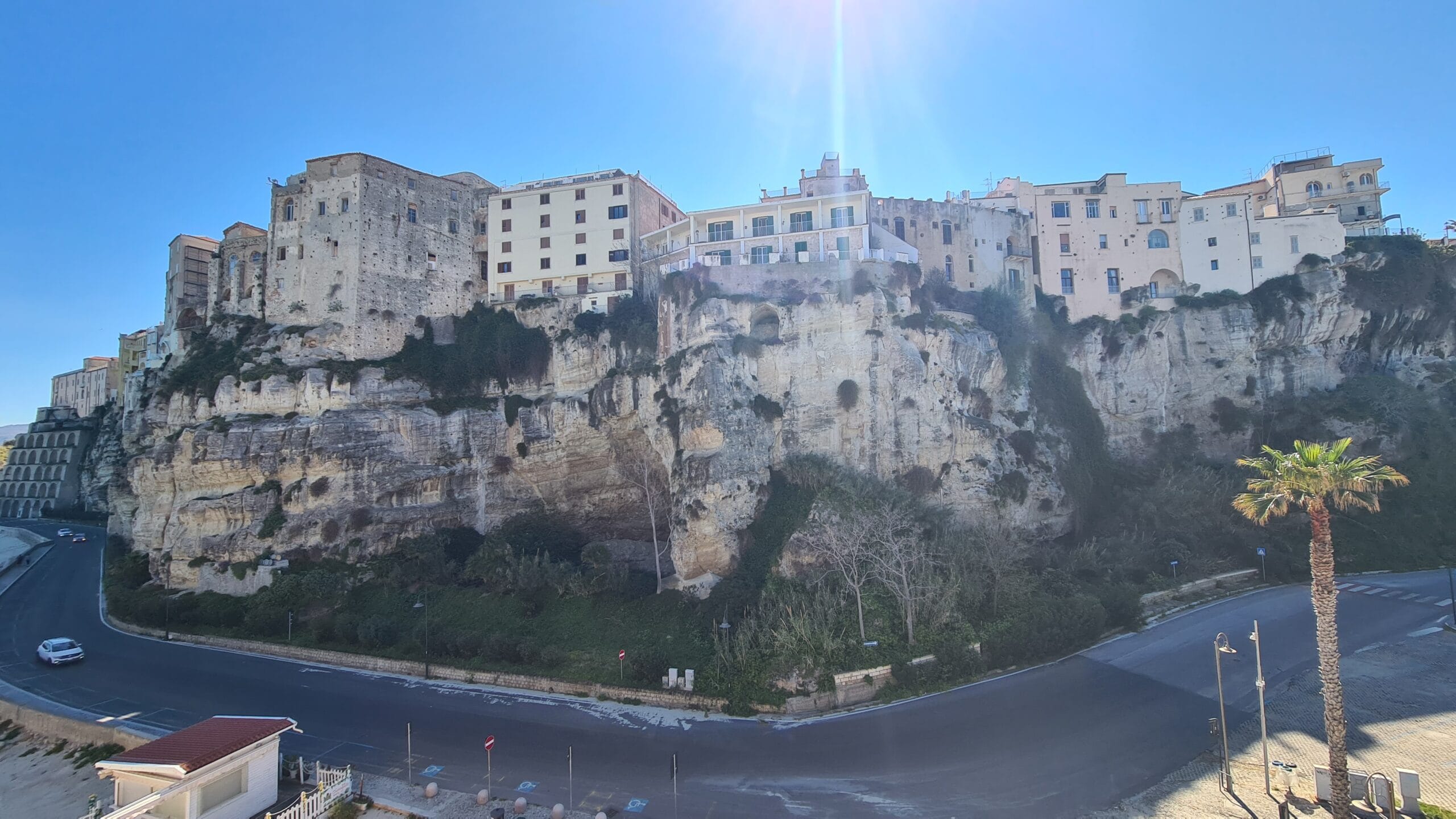
The monastery itself dates back to the Middle Ages, although the structure has been rebuilt and restored multiple times, especially after earthquakes. Today, it’s a serene little sanctuary surrounded by gardens, often mistaken by visitors for an island (hence “Isola”)—which it was, once upon a time, before the land connected naturally over the centuries.
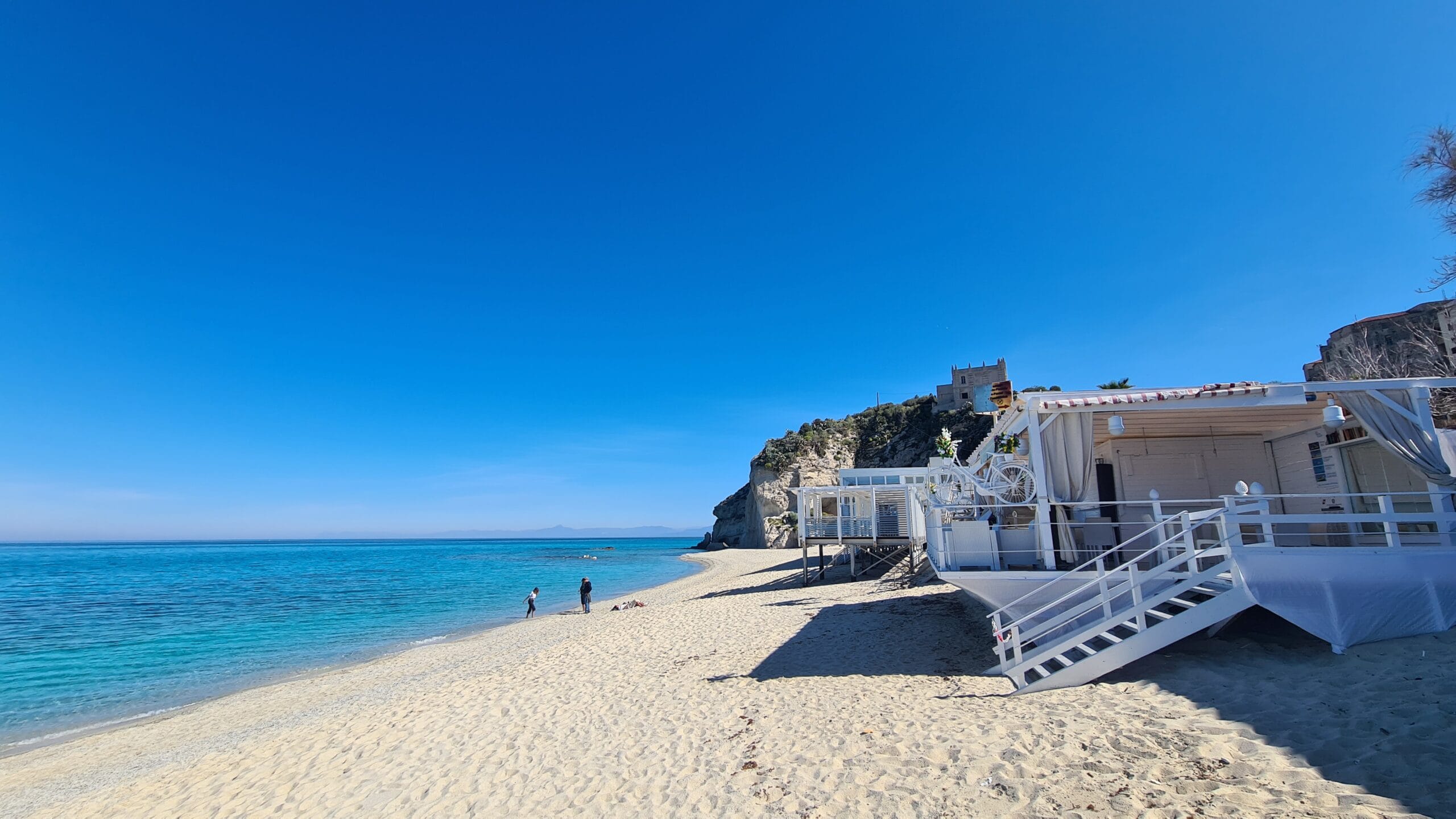
From the rocky heights to the sandy shores, Tropea’s drama doesn’t end at the monastery gates. If you’re up for a bit of exploration, the staircase near the Belvedere Piazza del Canone leads down to not only a different perspective of Tropea’s beauty but access to its beaches.
We descended the winding steps from the old town and emerged onto a stretch of coastline that seemed almost too good to be true. And yet, it was all there: the sparkle, the salt, and the slightly smug feeling of having found something this beautiful without needing a plane to the Maldives.
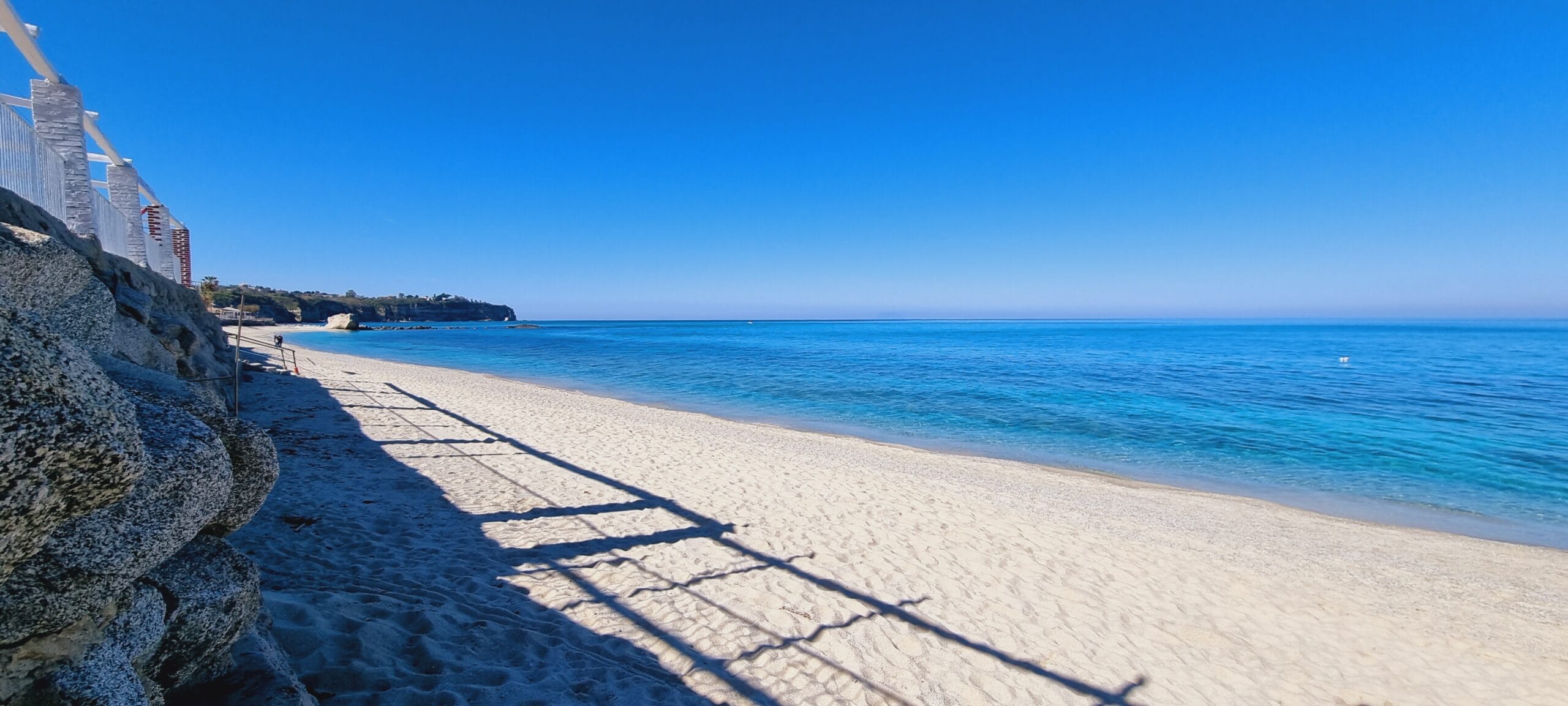
Our beach day was brief, after initially being glorious, the wind got up, and as it was still March, there was a definite chill in the wind! But, it was the first chance we’d really had to sit, relax, read and soak up some vitamin D.
The water here is so clear it practically sparkles. You can stand waist-deep and still count your toes. Visibility is excellent for snorkelling (if you’re into that sort of thing), and the gentle waves make it safe for swimmers of all abilities.
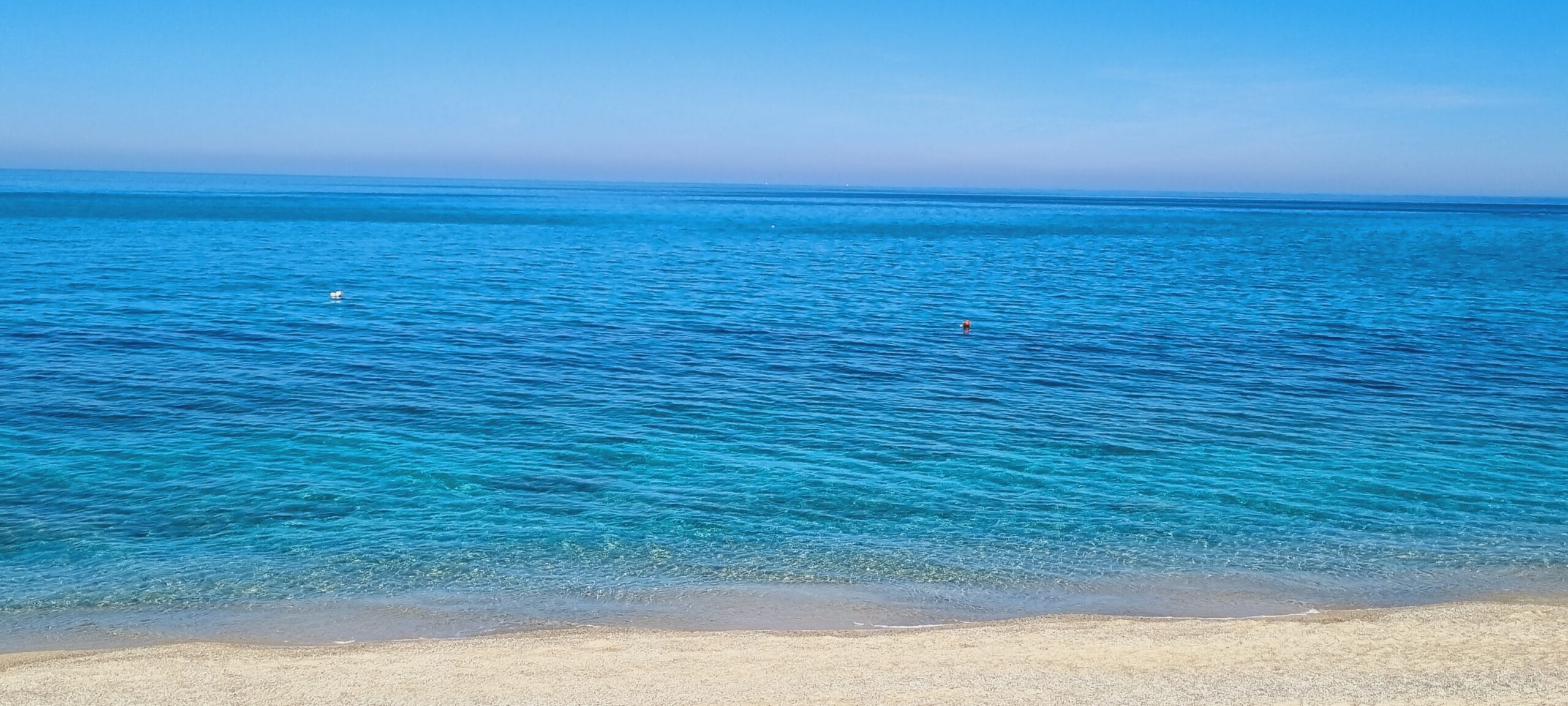
The sand varies—some areas are silky and fine, others more pebbly—but it all felt gloriously unspoilt when we visited.
The beaches on offer:
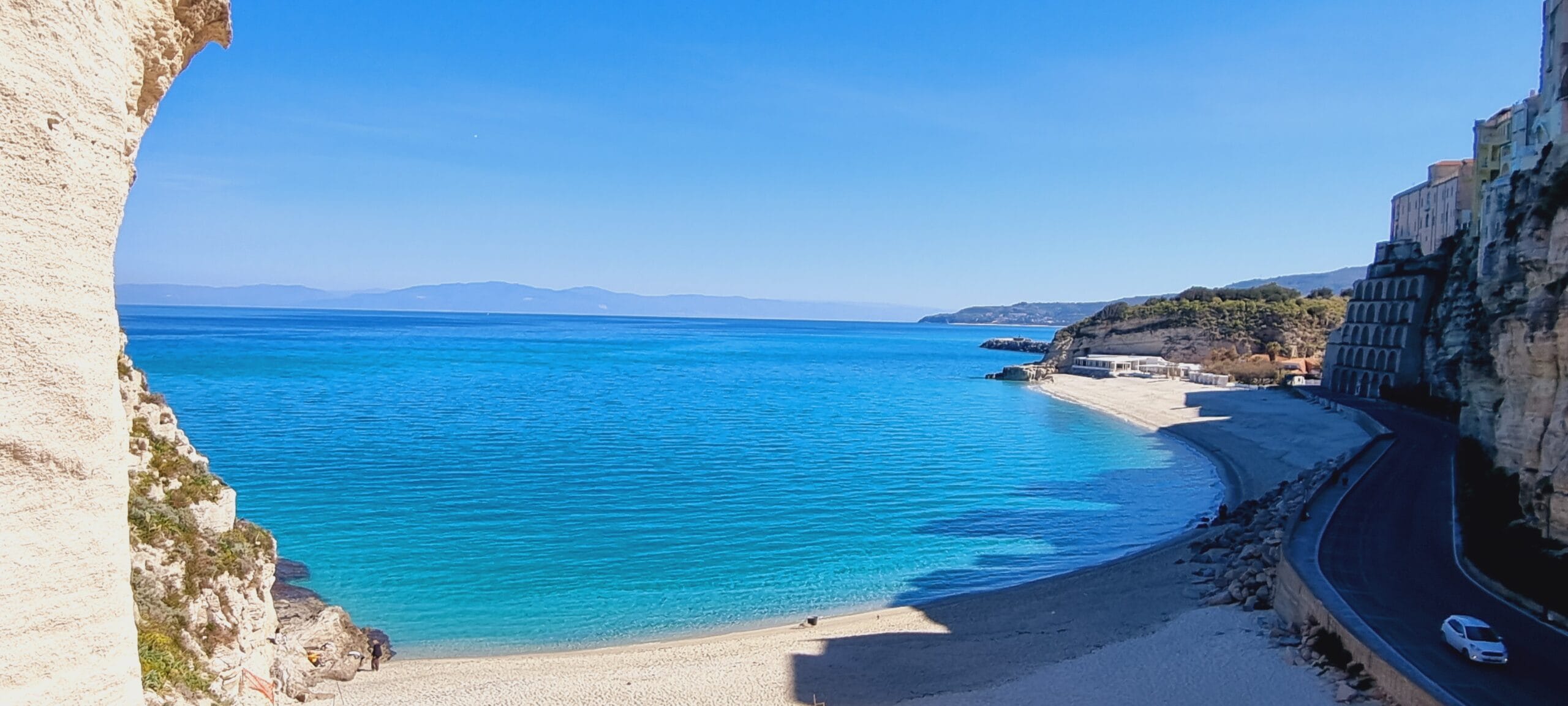
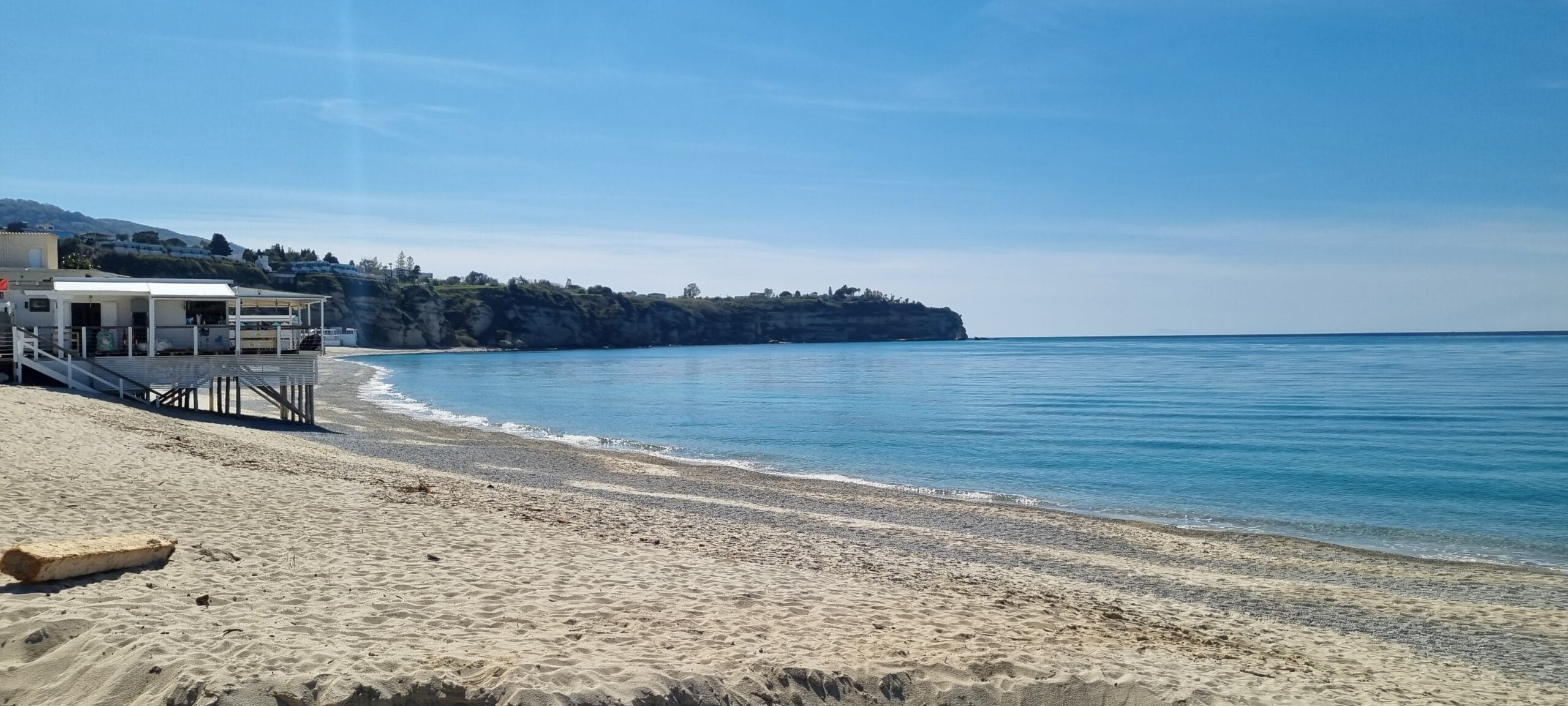
Tropea doesn’t just sit above the sea—it rises out of legend, history, and the occasional earthquake. This cliffside town on the Costa degli Dei (Coast of the Gods) has a backstory that’s as dramatic as its setting.
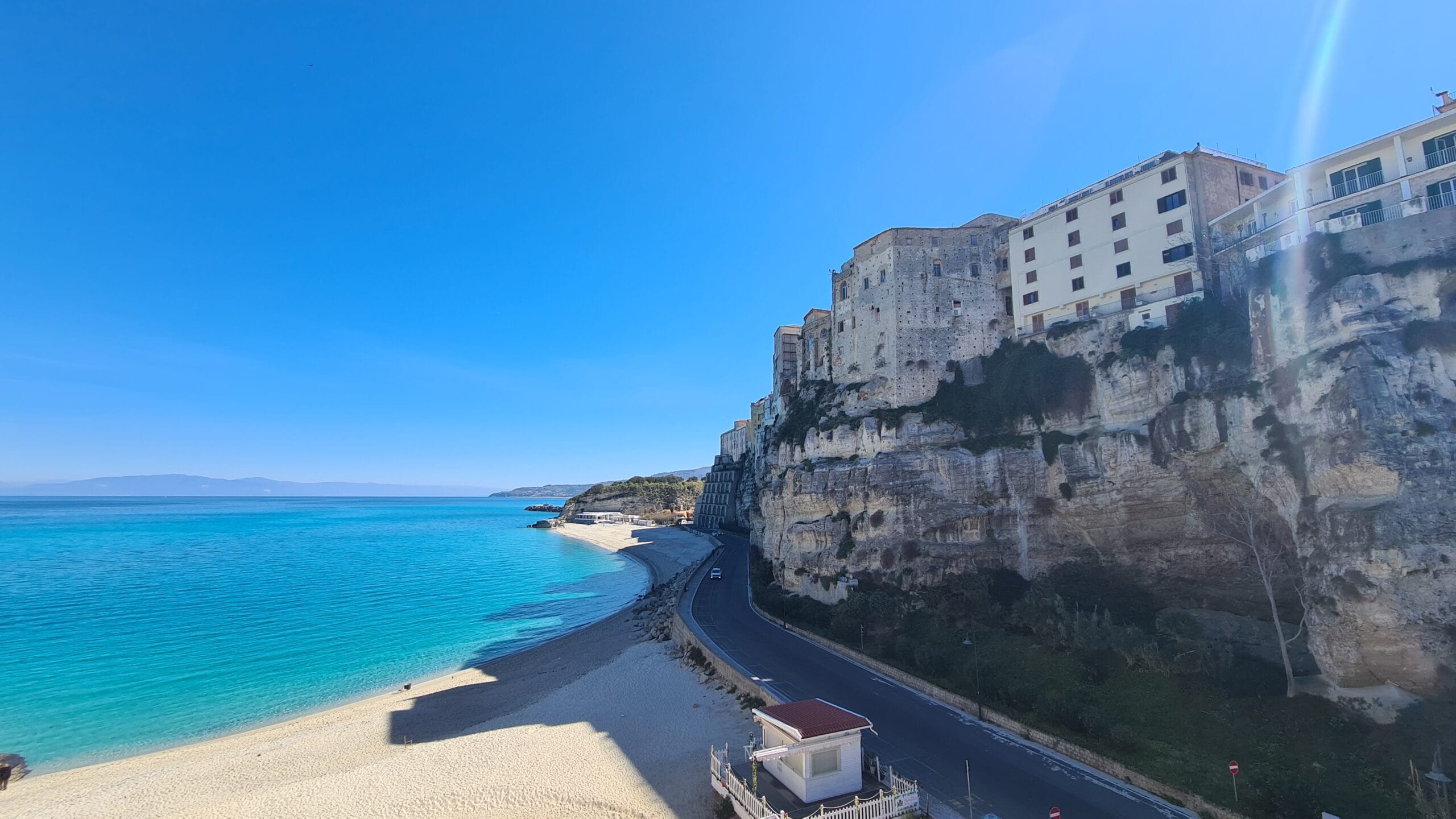
Hercules Slept Here (Apparently)
Let’s start with the myth: legend has it that Hercules, fresh from his labours at the Pillars of Hercules (modern-day Gibraltar), passed through this coastline on his way back from battle and founded Tropea. There’s no archaeological proof of that, of course—but when you look at the setting, you wouldn’t be surprised if a demi-god had holidayed here.
Tropea’s location along this stretch of dramatic cliffs and turquoise waters has long been associated with mythological wanderers. The ancient Greeks believed this was a land touched by the gods, and it’s easy to see why: it has that eternal sunlight and salty magic that makes you think anything’s possible.
Romans, Byzantines and Normans
From myth to concrete history, Tropea was known to the Romans as an important coastal outpost and trading port. It even earned a mention from Pliny the Elder, who documented its early prominence. Thanks to its natural harbour and elevated vantage point, Tropea was prized both for commerce and defence.
In the 6th century, Tropea came under Byzantine control, and this is when its role as a fortified coastal watchpoint truly took shape. The town was one of three principal “watchtowers” in the region, protecting against raids.
Later, the Normans arrived in the 11th century, leaving behind traces of their architectural influence, particularly in Tropea’s cathedral, which still bears scars from past battles—look closely and you’ll spot cannonballs embedded in its stone walls.
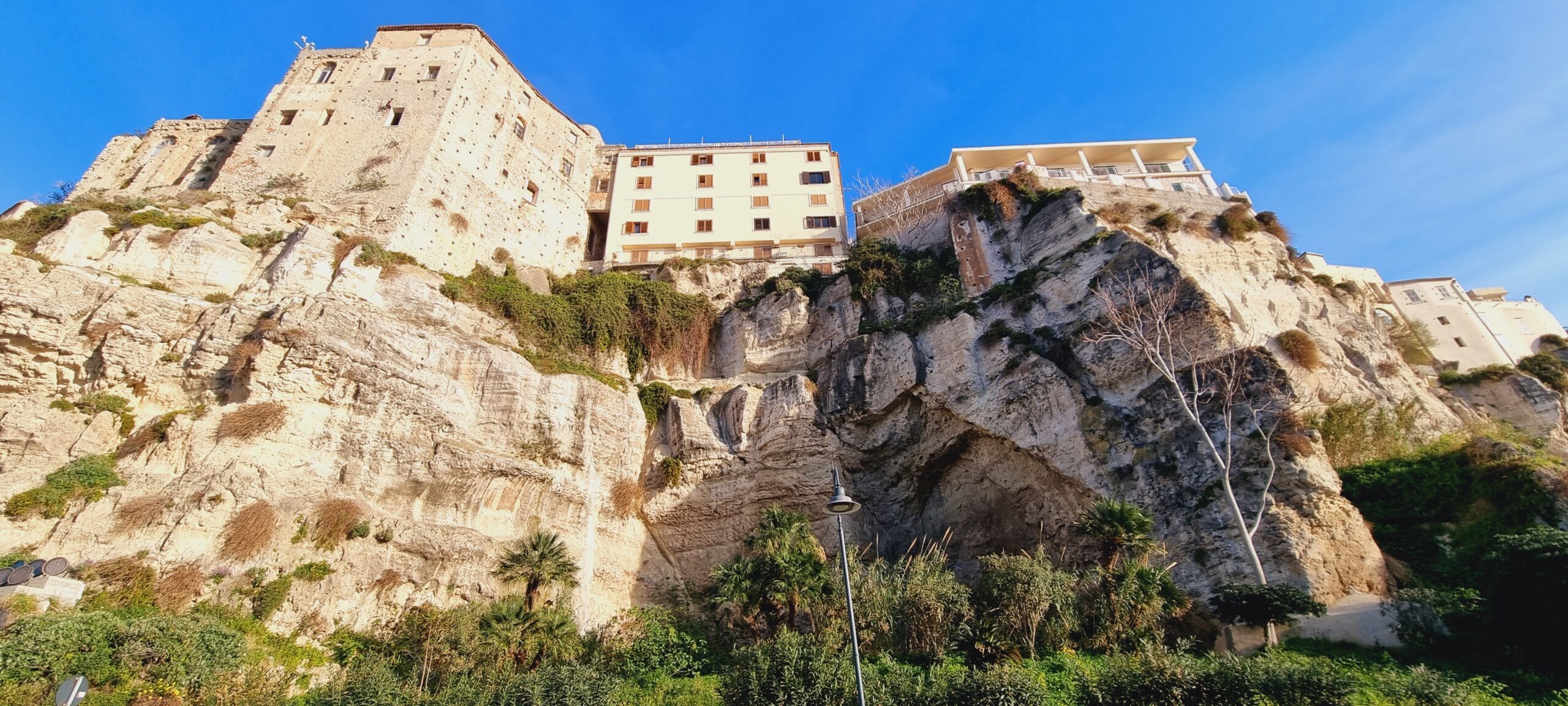
A Town Built to Withstand
Tropea’s position on the cliff was more than scenic—it was strategic. The old town was encircled by defensive walls, gates, and narrow alleys designed to confuse invaders. You can still see parts of these medieval fortifications as you wander through the centro storico. Earthquakes and invasions may have shaken the town, but its resilience is part of its soul.
A Bishop’s Seat and a Noble Retreat
From the Middle Ages through the Renaissance, Tropea became known as an ecclesiastical and aristocratic centre. It was once the seat of a bishop and a refuge for noble families, many of whom built the elegant palazzi that still hang precariously over the cliff edge today—pastel beauties with flaking shutters and spectacular sea views.
Living Legend
Today, Tropea wears its past like a faded velvet jacket—slightly frayed, full of stories, and all the more charming for it. Whether you believe the Hercules tale or not, there’s something undeniably mythic in the way the sun sets over Stromboli and the waves crash beneath the old town’s feet. A place shaped by gods, guarded by warriors, and now—just maybe—kept alive by wanderers like us.
But while Tropea’s history is full of noble titles and divine sunsets, it wasn’t always so peaceful… It’s easy to look at Tropea today—perched peacefully on its cliffs—and forget that it was once on the front line of some fearsome pirate raids.
Back in the Middle Ages and early modern period, the Tyrrhenian Sea was crawling with danger. Saracen pirates (Arab raiders from North Africa) and later Ottoman corsairs, like the notorious Barbarossa, terrorised the coastline. Tropea, with its prime location, became a repeated target. The invaders weren’t after gelato—they came for gold, goods, and captives.
Tropea’s residents responded the only way they could: by turning the town into a fortress. The Byzantines first fortified it in the 6th century. Over time, the walls were reinforced, watchtowers were built, and escape tunnels were rumoured to run beneath the old town.
Some legends even speak of hidden treasure or haunted stretches of coast, where pirate ships once anchored under cover of darkness. While there’s no confirmed loot buried beneath the cliffs, the stories add another layer of mystery to Tropea’s already mythical air.
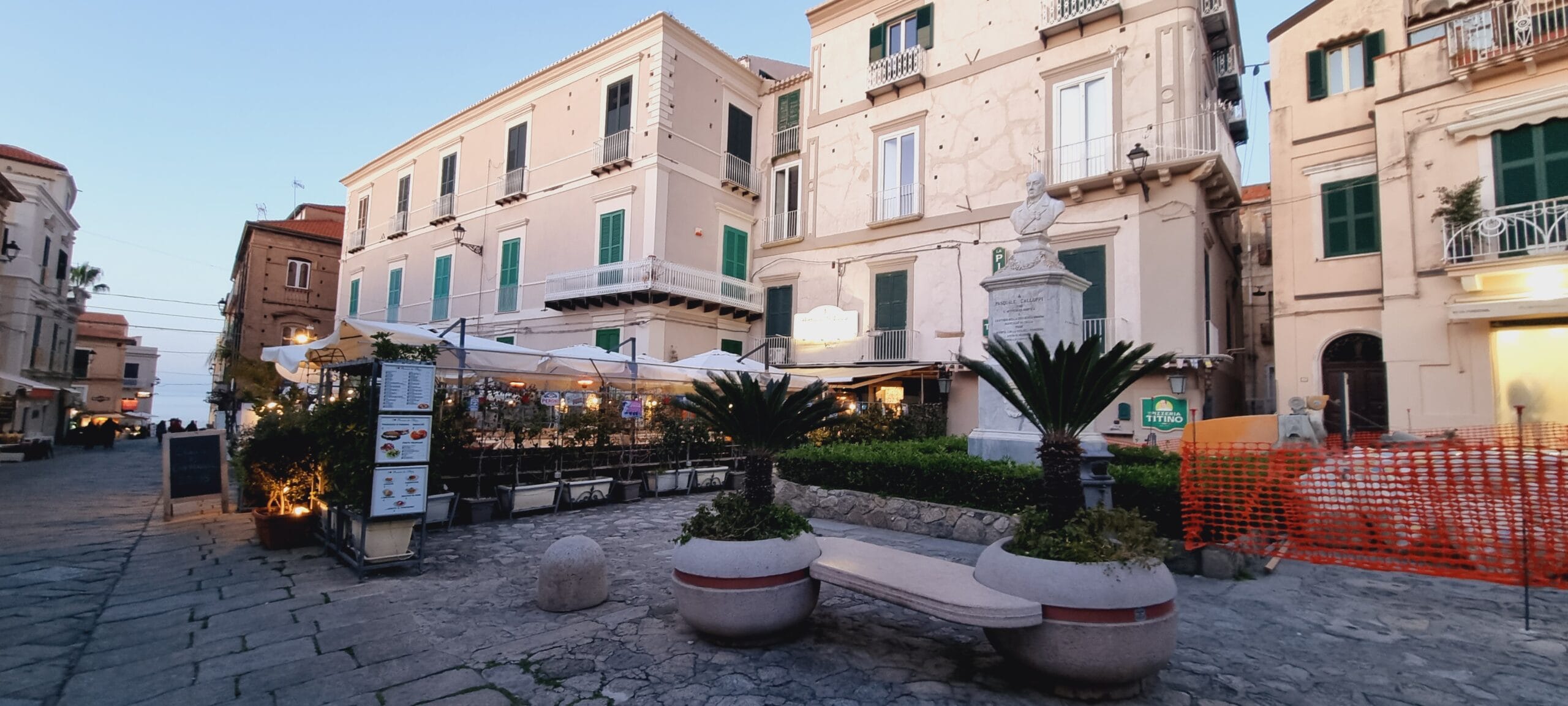
For those who don’t like to sun worship, you may prefer to stay up top in the historical Old Town. The streets are dotted with charming cafes, restaurants and shops, perfect for a leisurely stroll.
With the narrow, maze-like alleys of the old town—designed to confuse invaders and slow their progress—you see traces of the town’s defensive mindset.
Some of the buildings look weather-beaten, which is hardly surprising given the position on an outcrop. In fact, it’s a testament to the craftspeople who built the town that so much of it is still charming.

 On our first night, we strolled, looking at first for some of Zoe’s researched restaurants, only to find them closed. All of them! Unfortunately, too early in the season for them or the just wrong day of the week.
On our first night, we strolled, looking at first for some of Zoe’s researched restaurants, only to find them closed. All of them! Unfortunately, too early in the season for them or the just wrong day of the week.
But wandering the old town’s narrow streets we stumbled across Le Vulpi e L’Uva (The Foxes and The Grapes – a name that is attributed to one of Aesop’s most famous fables – we’re not sure the significance of the name for the restaurant, but there’s probably a story there).
Le Vulpi e L’Uva is full of rustic charm, chalkboards for menus propped up next to your table, checked table cloths, heavy wooden furniture, wine bottle rack lined walls and just the owner/chef running the show all by himself! Needless to say, there were only handful of tables; there were more outside, but it was far too cold. About 15 minutes after we turned up, another chef did appear for his shift, which was timely as the restaurant was now turning people away.
We started with a mix of Calabrian cheeses and some of beautifully sweet jam made from Tropea onions, our first introduction to the town’s most famous produce. It didn’t disappoint. Our only problem, how can we carry multiple gift jars of the stuff for the next 3 months across multiple countries without breaking or eating it all! In the end, we left the onion jam in Tropea, but with our perspective on caramelised onion chutney changed, we don’t think anything will match that jam with cheese!
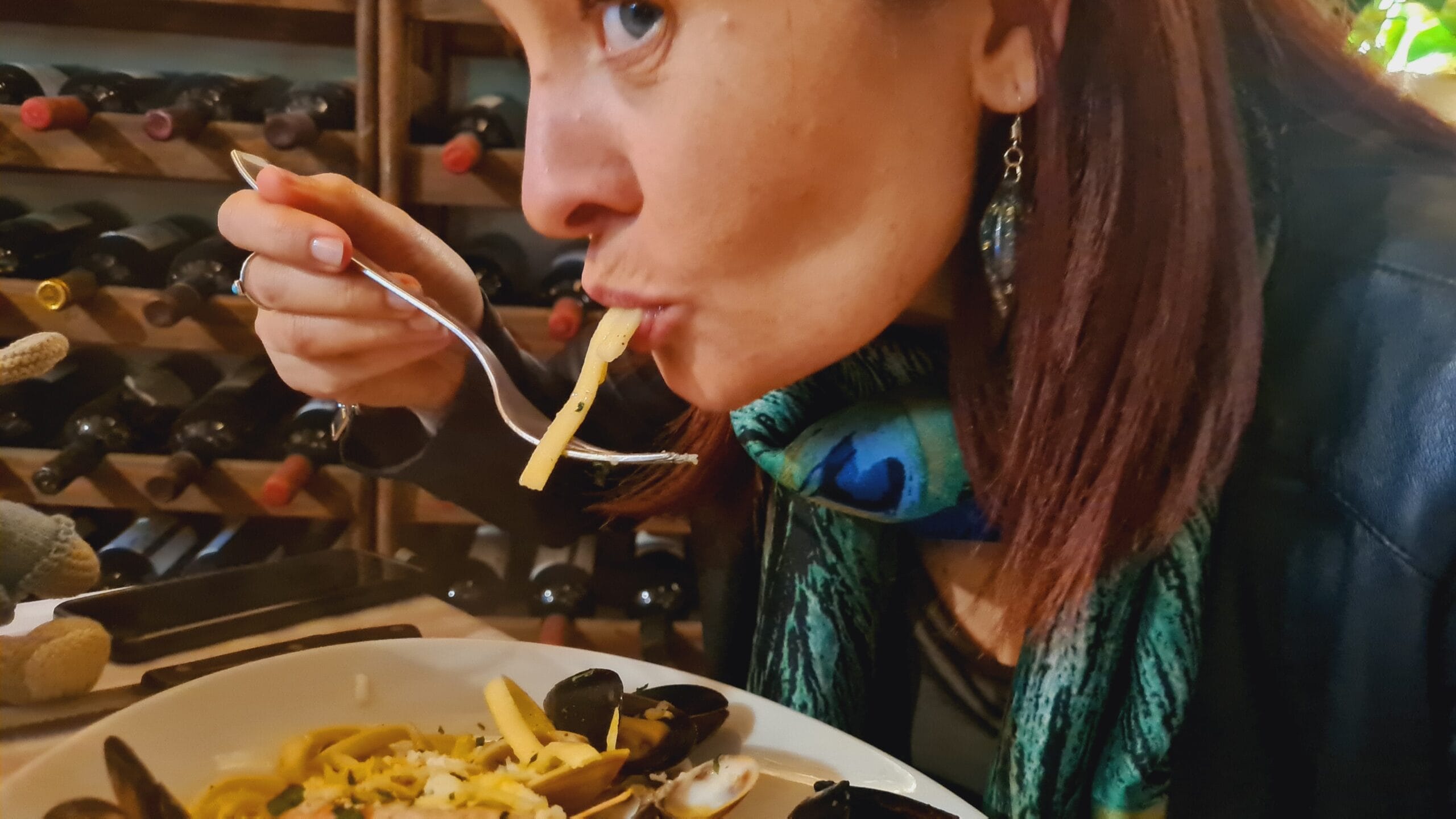
When you’re by the sea, it’s hard to ignore the seafood on offer. Grilled king prawns, Scialatelli with Mussels and Clams and Paccheri with Swordfish and Pine Nuts all followed. All great, warming plates of Italian cuisine you long for at home.
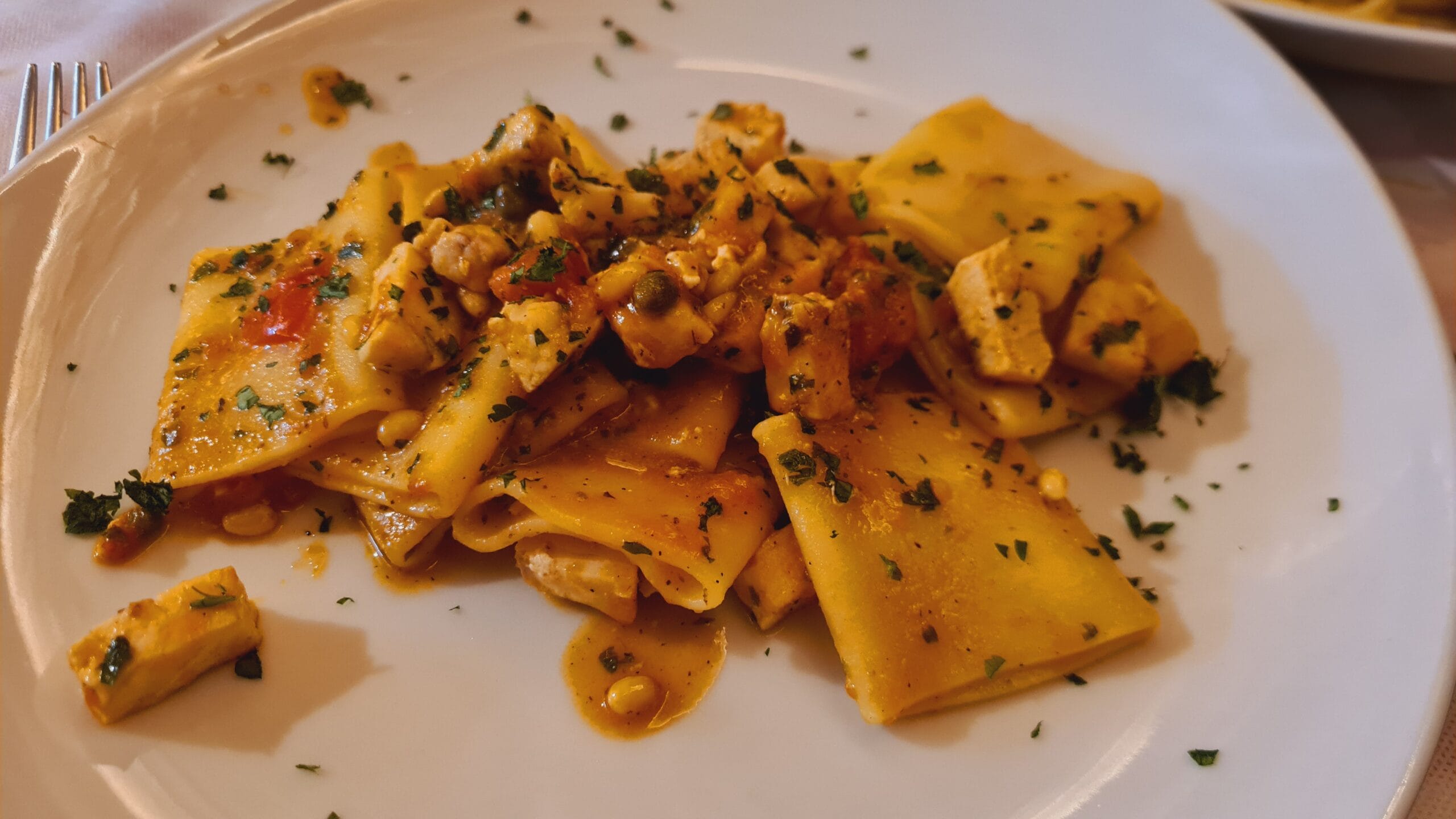
On our second night, we were sorely tempted to go back to Le Vulpi e L’Uva, and we probably would’ve had we not stopped at Deodato for a drink. Badged as a “lounge bistro wine bar” we thought it would be a good place to stop for a glass of wine before seeking out food. We were right, but not for the reasons we expected!
To enter Deodato you have to go down some steps to an almost hidden entrance. Heading through the doors, we realised this was slightly more upmarket than other “lounge bistro wine bars” we’d frequented. Immaculately decorated to give it that premium yet relaxed and welcoming feel, we almost walked straight back out before a welcoming voice called to us from down a spiral staircase.
Because it was still early, the place was deserted. But that’s ok, we were just after a nice glass of wine and would then head for dinner. What we then got was five star service and then some.
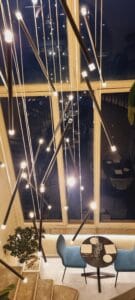 As we descended the spiral staircase there was a single table for two in front of a massive window that looked out over the sea. The light had gone but we could just about make out the drop beneath us to the sea highlighted by the lights of the monastery – we were sat inside the cliff face.
As we descended the spiral staircase there was a single table for two in front of a massive window that looked out over the sea. The light had gone but we could just about make out the drop beneath us to the sea highlighted by the lights of the monastery – we were sat inside the cliff face.
Perusing the menu, we realised it was not a cheap place to drink or eat. But the view was stunning and we were just staying for a glass of wine, the damage to our wallet wouldn’t be too bad. When we ordered our two glasses of local red wine, the waiter offered us a little something from the kitchen, the Italians always like you to eat when you’re drinking. Sure, why not. We hadn’t clarified whether this little something was included, but too late now, if the bill is extortionate, we pay, and learn our lesson the hard way.
“A little” something from the kitchen turned out to be five of the most delicious and generous canapes we’ve ever had, each! We can’t quite remember what they all were but there was octopus carpaccio, tropea onions, delightful ham and asian inspired egg wrapped rice cake with different mayonnaises. What an absolute treat.
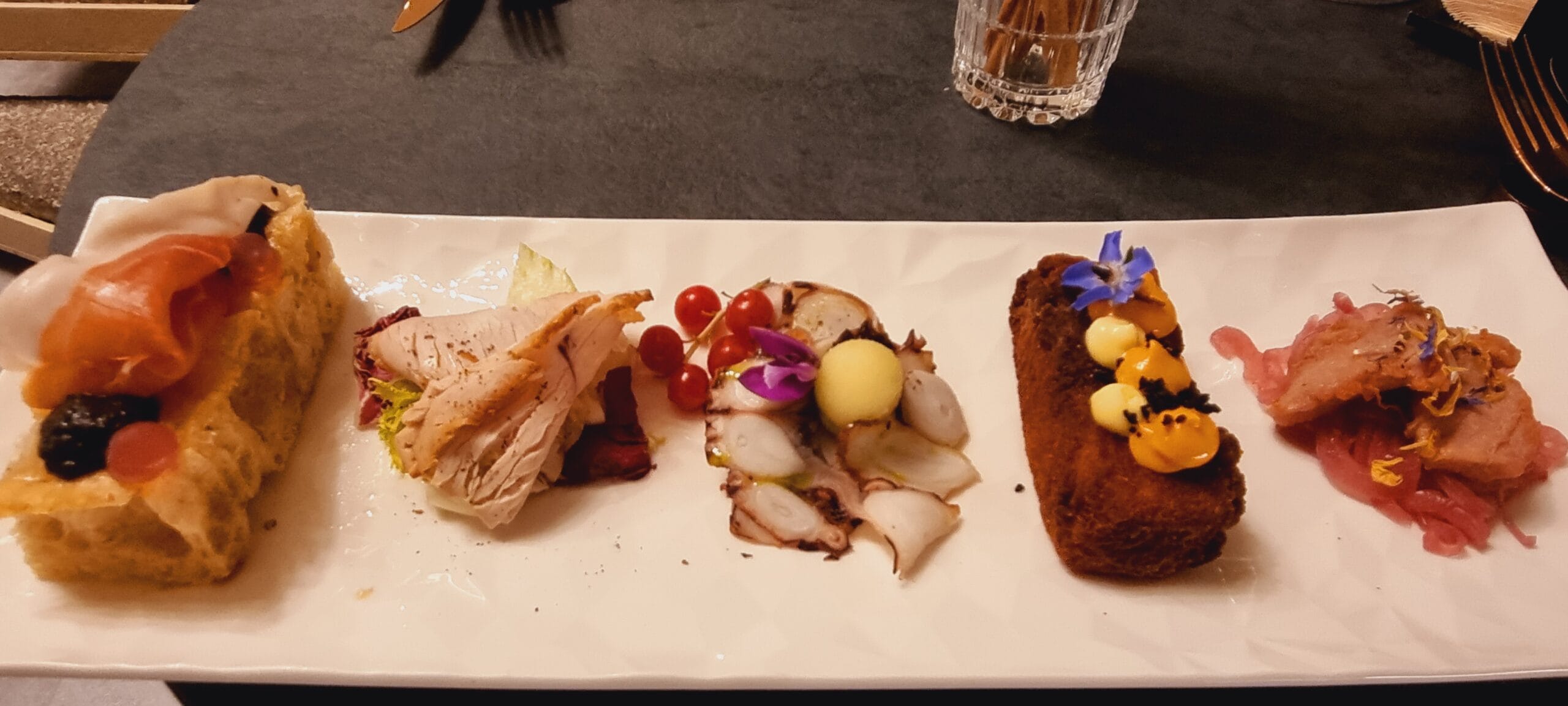
Then, as the waiter cleared our plates, he said he would bring us something sweet to try from the kitchen. To be honest, by this point, we didn’t care what the bill was going to be, we just wanted to try more of what the kitchen had to offer. It was all delicious and beautifully presented.
Six mini pastries to share were delivered to our table. We tried our best to share them, although we each seemed to take a rather larger than half bite when going first, funny that!
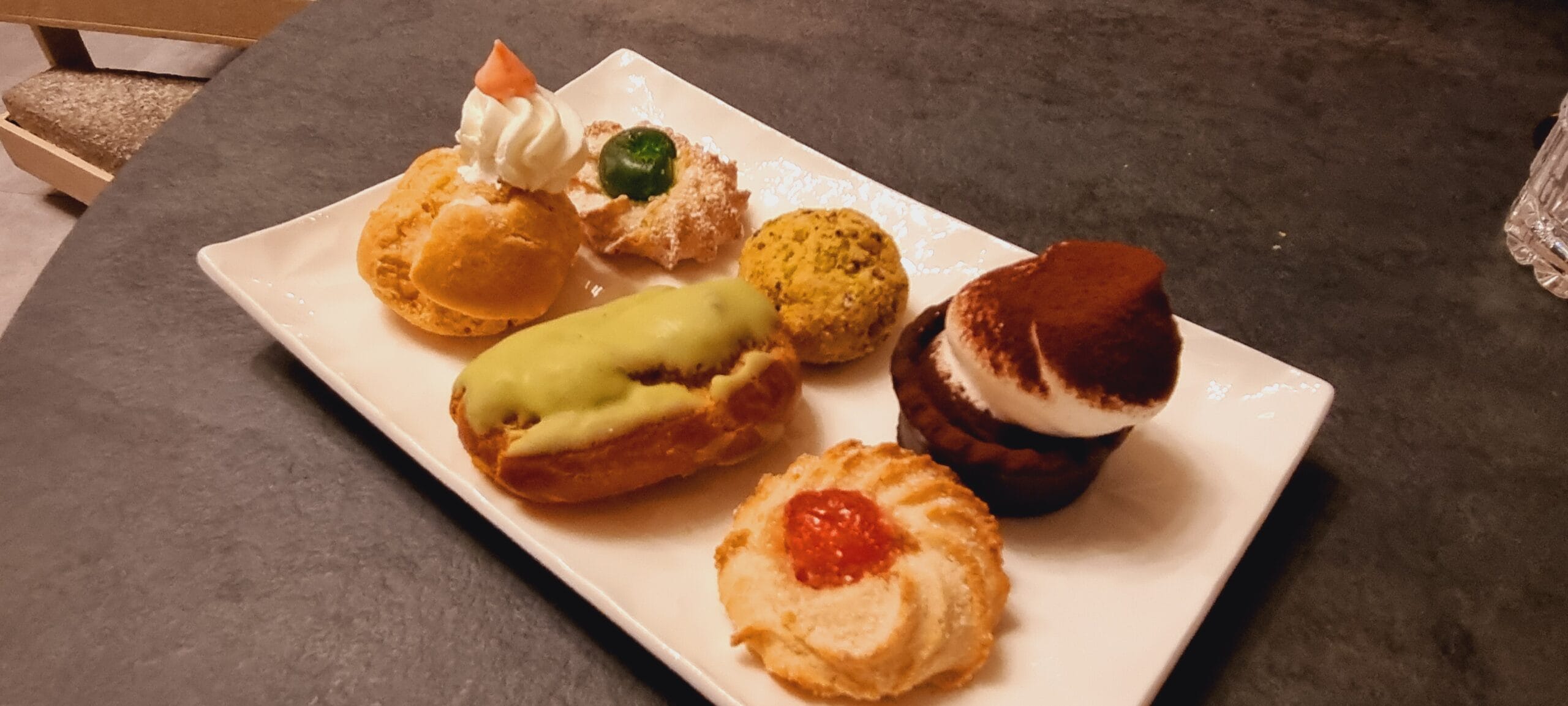
Now, not really needing dinner, we thought it best to settle the bill. Sure enough, we just paid for the wine, everything else was, incredibly, on the house! I was beckoning Zoe to get out of there in case a mistake had been made but, as per usual, Zoe had managed to strike up a conversation telling someone about our trip. That someone turned out to be the lovely Nicola, the restaurant manager.
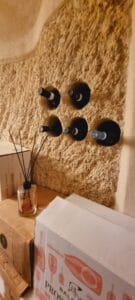 Nicola, explained how he had previously worked in Florence but was from the area and had relatively recently been tempted back to run Deodato. And then he took us on a tour. Heading back down the spiral staircase and into the wine cellar, going beyond to the private dining area and out onto a balcony on the cliff face overlooking the sea.
Nicola, explained how he had previously worked in Florence but was from the area and had relatively recently been tempted back to run Deodato. And then he took us on a tour. Heading back down the spiral staircase and into the wine cellar, going beyond to the private dining area and out onto a balcony on the cliff face overlooking the sea.
Once I got over the worry we were going to be thrown from the balcony for not ordering more or some other bill related misunderstanding, and realising that it was just good old Calabrian hospitality, I tuned back in.
It was here, Nicola told us, that he spent half an hour most mornings, with nothing but a good coffee and his thoughts, listening to the sound of the Thyrrenian lap at the beaches of Tropea. What a privilege, what a wonderful perk of coming to work every day!
As we went back into the private dining area, Nicola pointed out in the walls there were still original grooves from the pickaxes used to cut these rooms into the rock. I’m sure he mentioned pirates and treasure, but probably got distracted by the thought of spending a beautifully long evening in the private dining space ending with a whisky on the balcony. But as I have since found out, maybe these were indeed originally dug to hide away from pirates or by pirates for smuggling, either could be true with Tropea’s history.
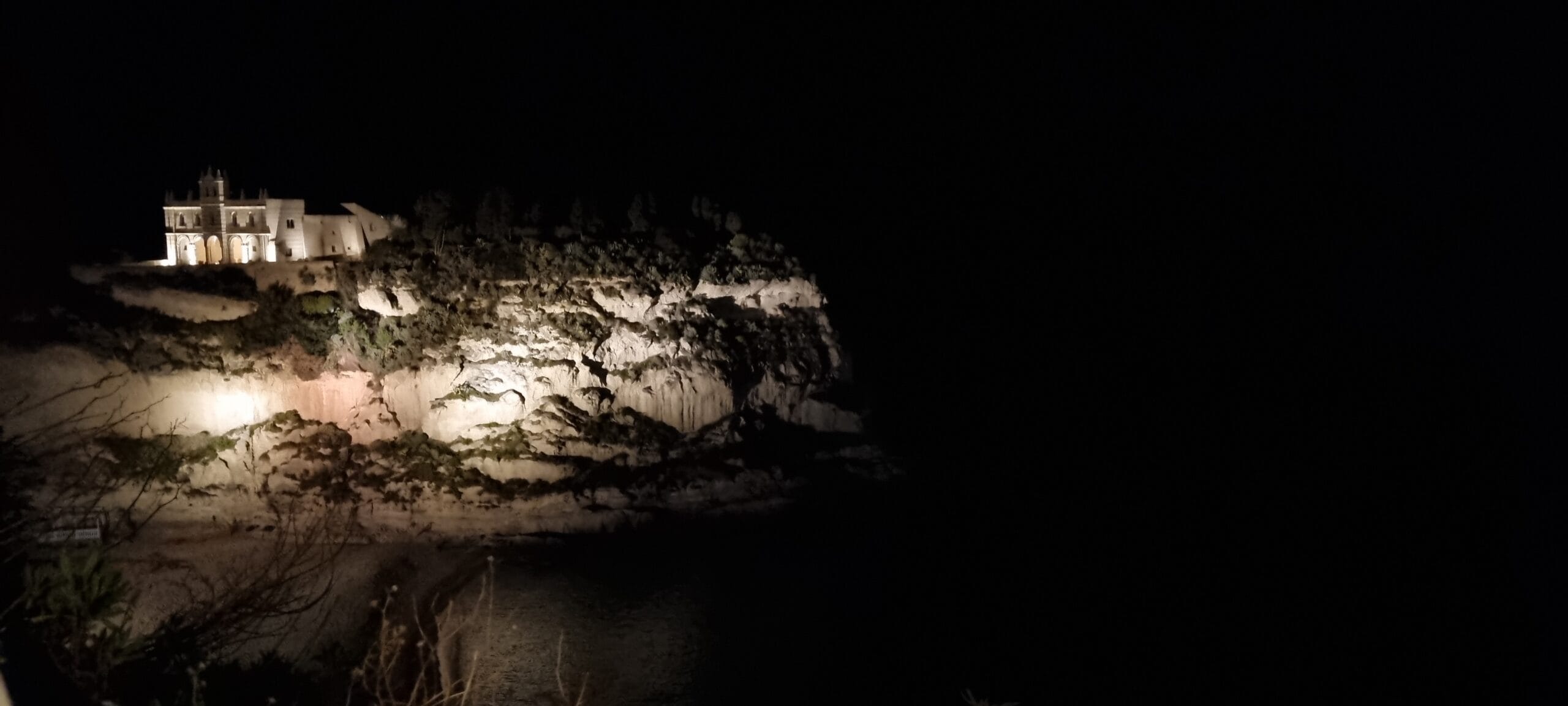
Nicola’s hospitality didn’t stop there, he said, we must take something sweet with us from the kitchen. We tried to explain we had already had some, but he was insistent we take them home and enjoy them tomorrow. So another six delicious sweet delicacies were handed to us in a lovely box.
Moments like this, of genuine, warm hospitality are things that really, money can’t buy. We hadn’t forked out for a 9 course tasting menu, booked a private dining experience, ordered their most expensive bottle of champagne and yet we were given the five star treatment. Obviously, if Zoe wasn’t the chatty one, none of this would’ve happened, so all credit to her friendliness that gets us into these fine messes.
And of those six exquisite pastries… only half of them lived to see the following day.
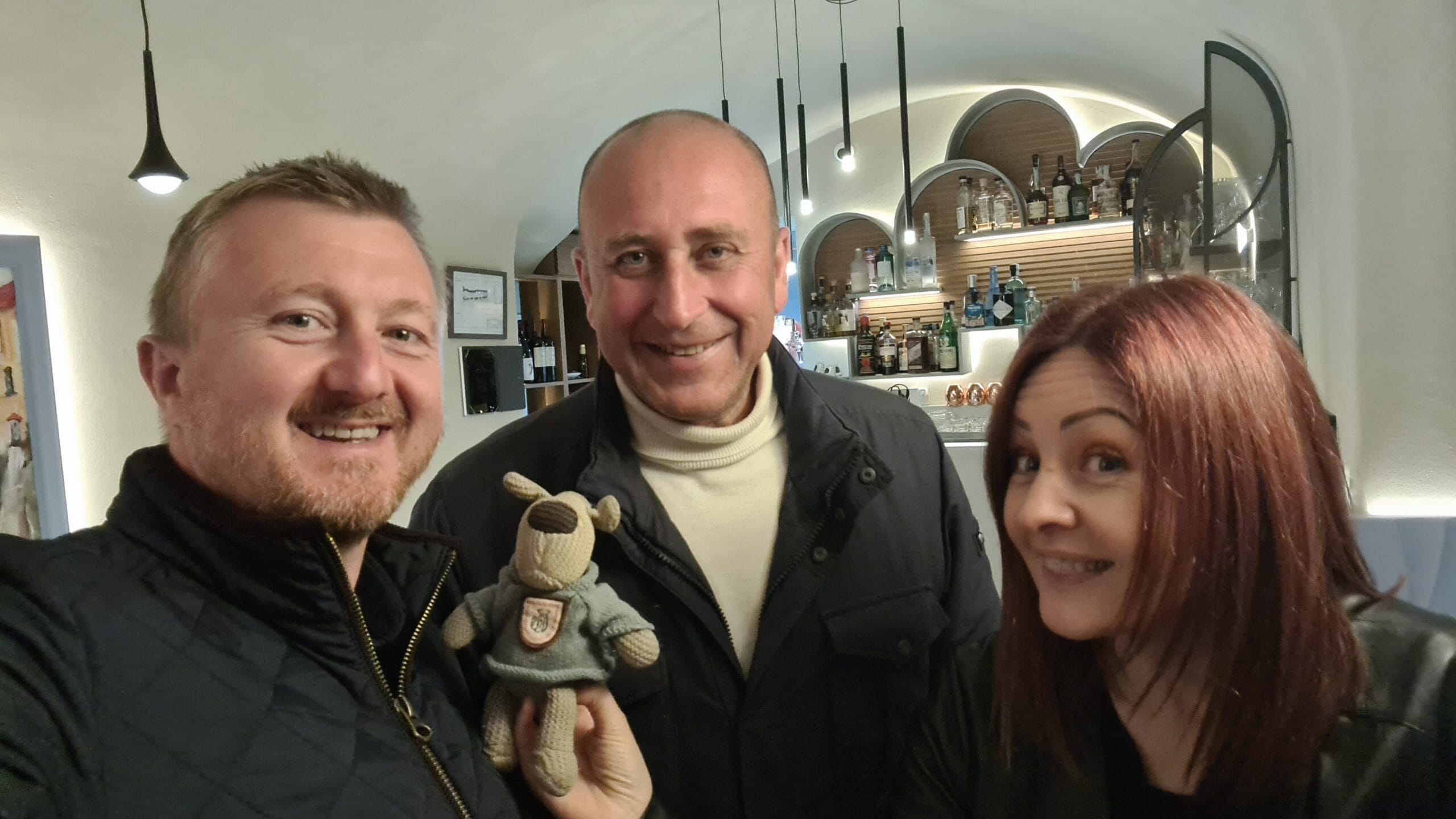
Let’s talk about those sweet sweet onions…
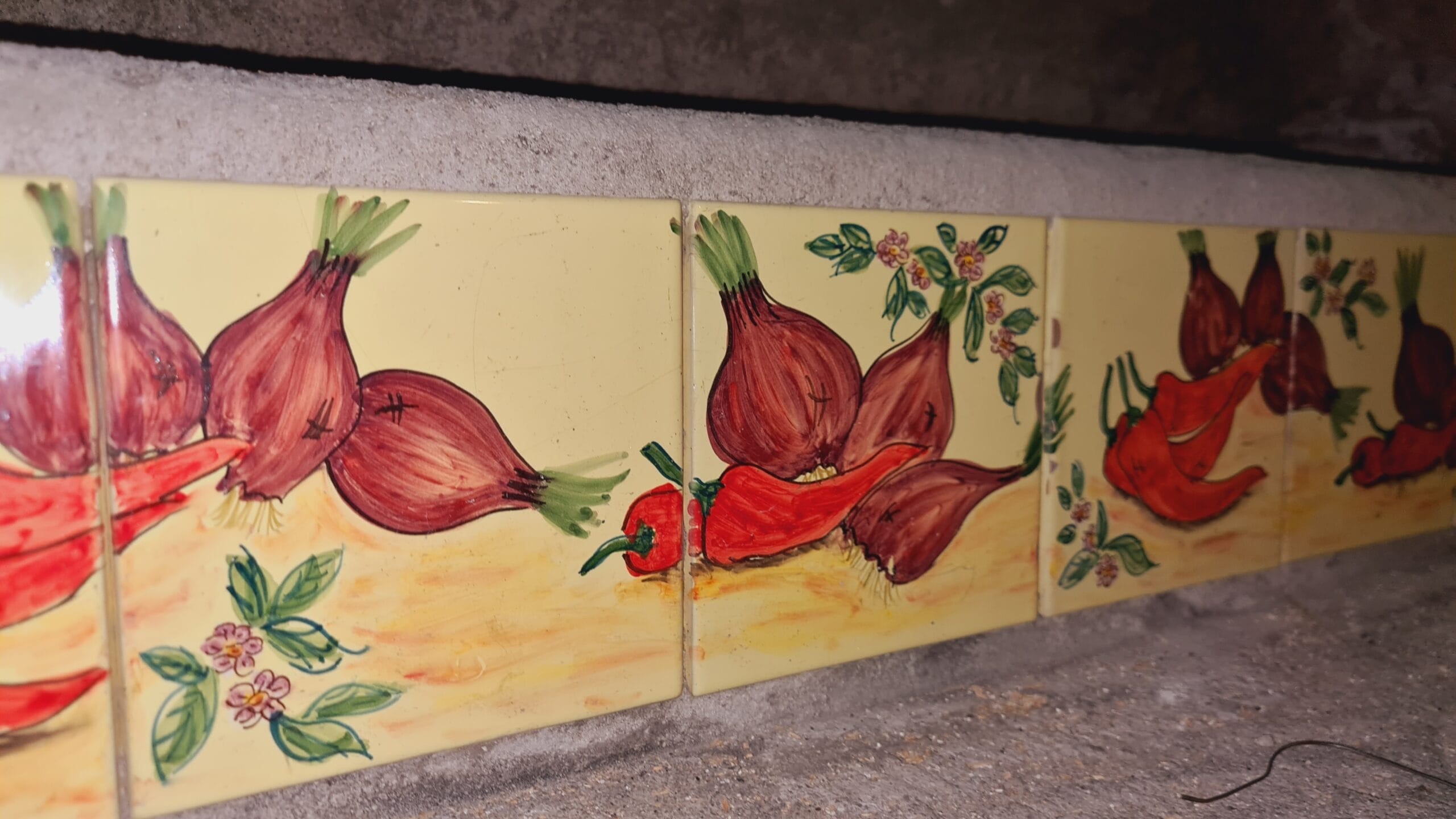
Forget diamonds—Tropea’s real gem grows underground. If you’ve spent any time in Calabria, you’ve probably noticed the locals getting misty-eyed over something that looks surprisingly humble: the red onion. But not just any onion. This is the Cipolla Rossa di Tropea, or La Regina Rossa (the red queen) and in these parts, it’s practically royalty.
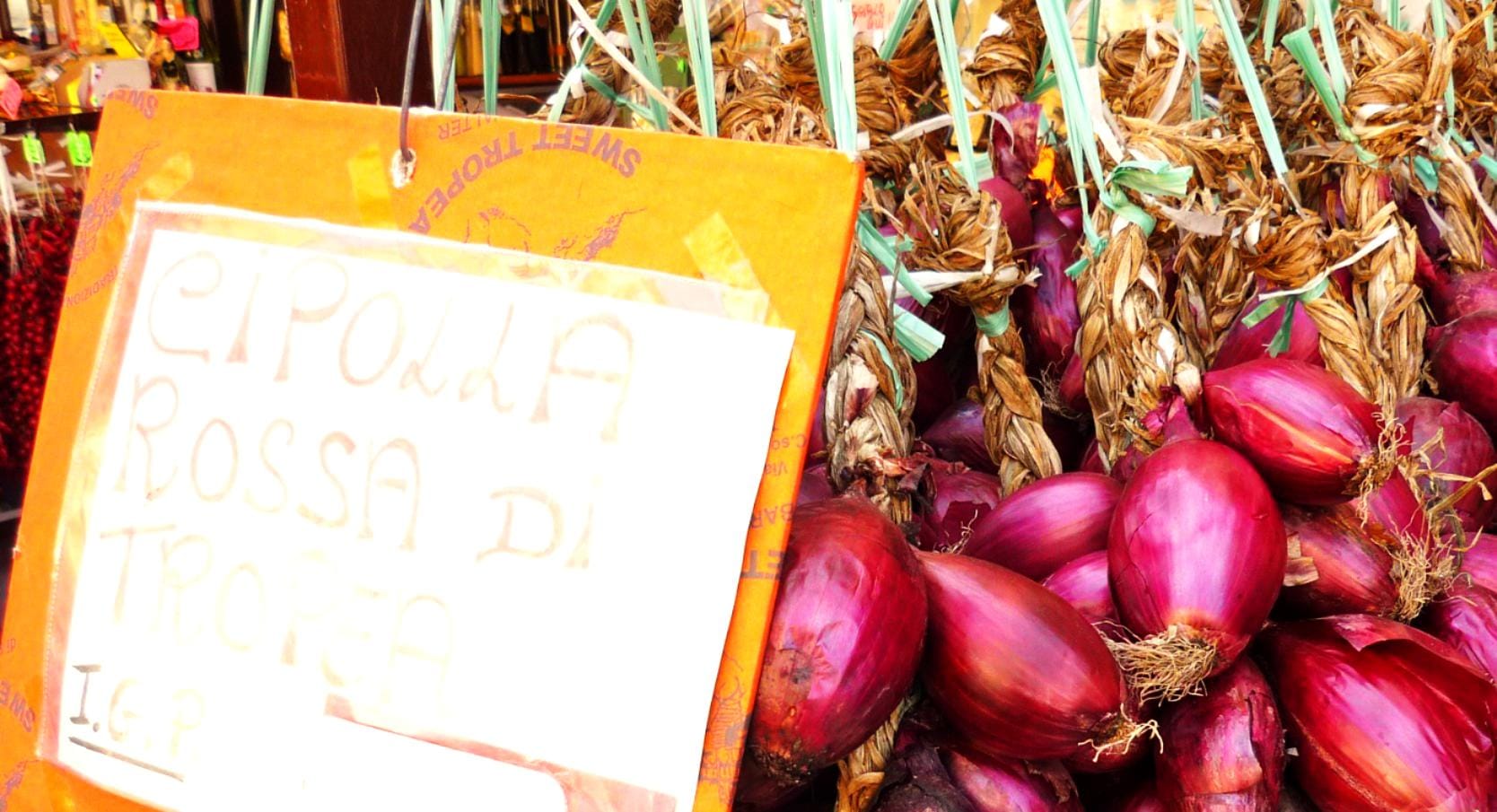
We weren’t expecting to fall in love with an allium. But this glossy, deep-purple beauty doesn’t just add colour to your plate—it adds history, sweetness, and a fair bit of local pride too. Soft, mild, and with none of the bite you’d expect from a raw onion, it’s sweet enough to eat like an apple (apparently – we didn’t dare try).
And, to be fair, not just Calabria celebrates the Tropea onion, when we asked about the ingredients of the ragu we had halfway up Vesuvius, guess what onions they used? Despite using other ingredients all from the most fertile volcanic land in Campania, they got their onions from Tropea!
Tropea’s unique location plays a big part. The onions thrive in the rich, sandy soils and coastal microclimate along the Tyrrhenian Sea—warm days, cool nights, and sea breezes. The result? An incredibly sweet, delicate flavour that sets them apart from their sharper, tear-inducing cousins.
They’ve been grown here for centuries, possibly since the Phoenicians or Greeks first brought them to the region. Today, they hold IGP (Indicazione Geografica Protetta) status, meaning they’re protected and recognised by the EU as being officially special—no imposters allowed.
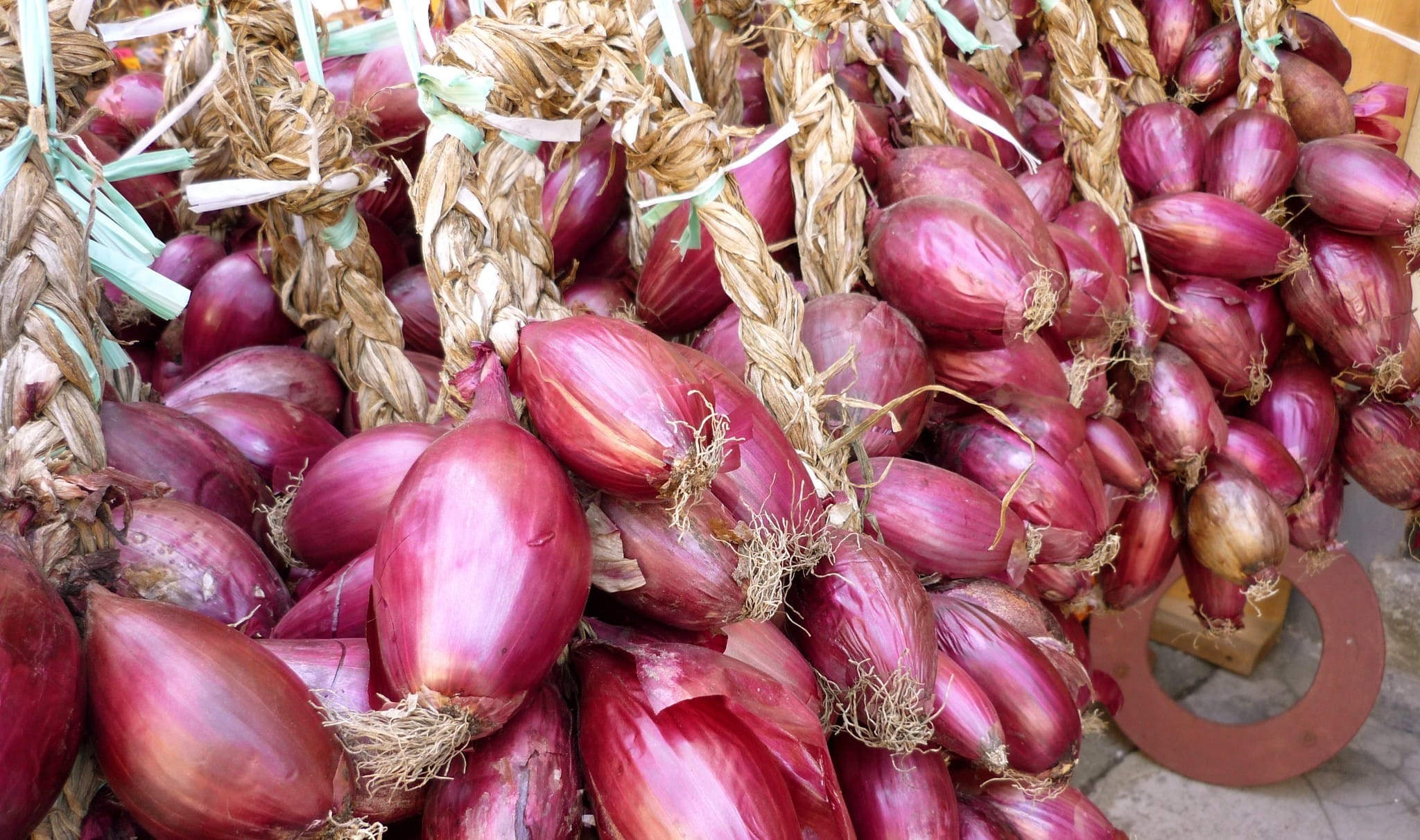
We saw them plaited into ropes and hanging from doorways like garlands. They’re served grilled, pickled, caramelised, turned into jam (delicious with cheese), or mixed into fresh tomato salads that just taste better under a Tropea sky. They even make cocktails with them.
Apparently, they’re also packed with health benefits—antioxidants, vitamin C, and all sorts of magical anti-inflammatory properties. Locals say they’re good for the heart, the immune system, and just about everything else. One vendor told us they might even help us live longer. Worth a try, right?
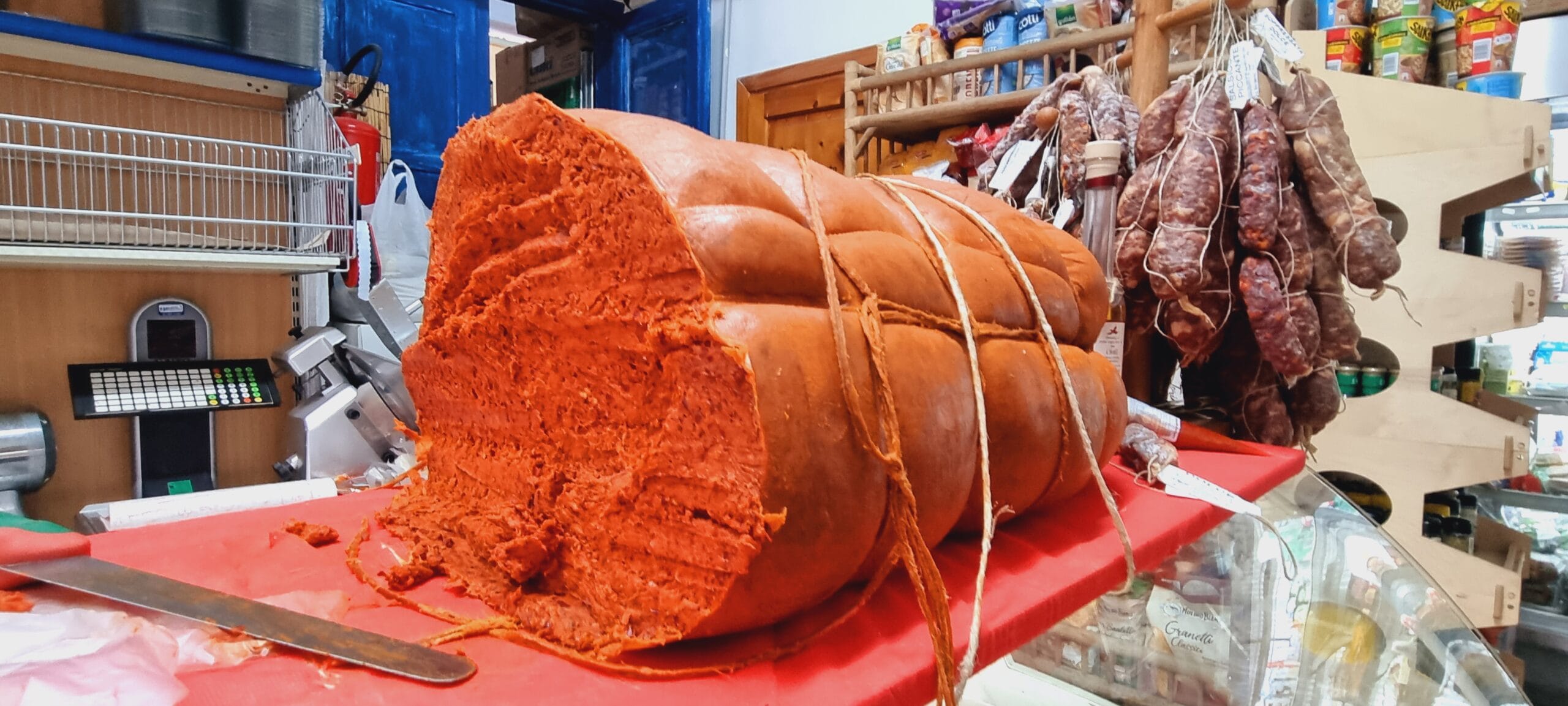
You also can’t visit this part of southern Italy without encountering ‘nduja. Pronounced “en-doo-ya”, this is not your average sausage. It’s a spicy, spreadable salami made primarily from pork, Calabrian chilli peppers, and a bit of magic—or at least that’s how it feels when it hits your tastebuds. Soft, smoky, and unapologetically hot, it adds a bold punch to pasta, pizza, bruschetta, or even scrambled eggs (trust us).
Nduja originated in Spilinga, a small hill town just a short drive from Tropea, and has long been considered a “poor man’s food.” It was traditionally made using less-prized cuts of pork—like cheek, belly, and trimmings—blended with generous amounts of sun-dried chilli pepper, salt, and fat. The mixture was stuffed into natural casings and lightly smoked, then left to cure until it reached that unmistakable soft, spoonable consistency.
It was a clever, resourceful way to preserve meat in the hot Calabrian climate—and over time, it became a beloved staple, not just in humble kitchens but at celebrations and local feasts too.
Although its birthplace is Spilinga, ‘nduja is proudly served all over Tropea and the surrounding coastline. You’ll find it on market stalls, antipasti platters, and menus from beach bars to fine restaurants. It pairs especially well with local products—smeared onto warm bread with Tropea red onion jam, stirred into a tomato sauce, or even dolloped onto grilled swordfish.
Many local delis offer artisan versions, with variations in spice levels and texture. And if you’re lucky, you might even catch a festival featuring ‘nduja in Spilinga in early August—yes, there’s a whole festival dedicated to the stuff.
Nduja isn’t just a food here—it’s part of the cultural fabric. It speaks to Calabria’s bold flavours, resilient traditions, and fiery personality. Just don’t say we didn’t warn you about the spice…
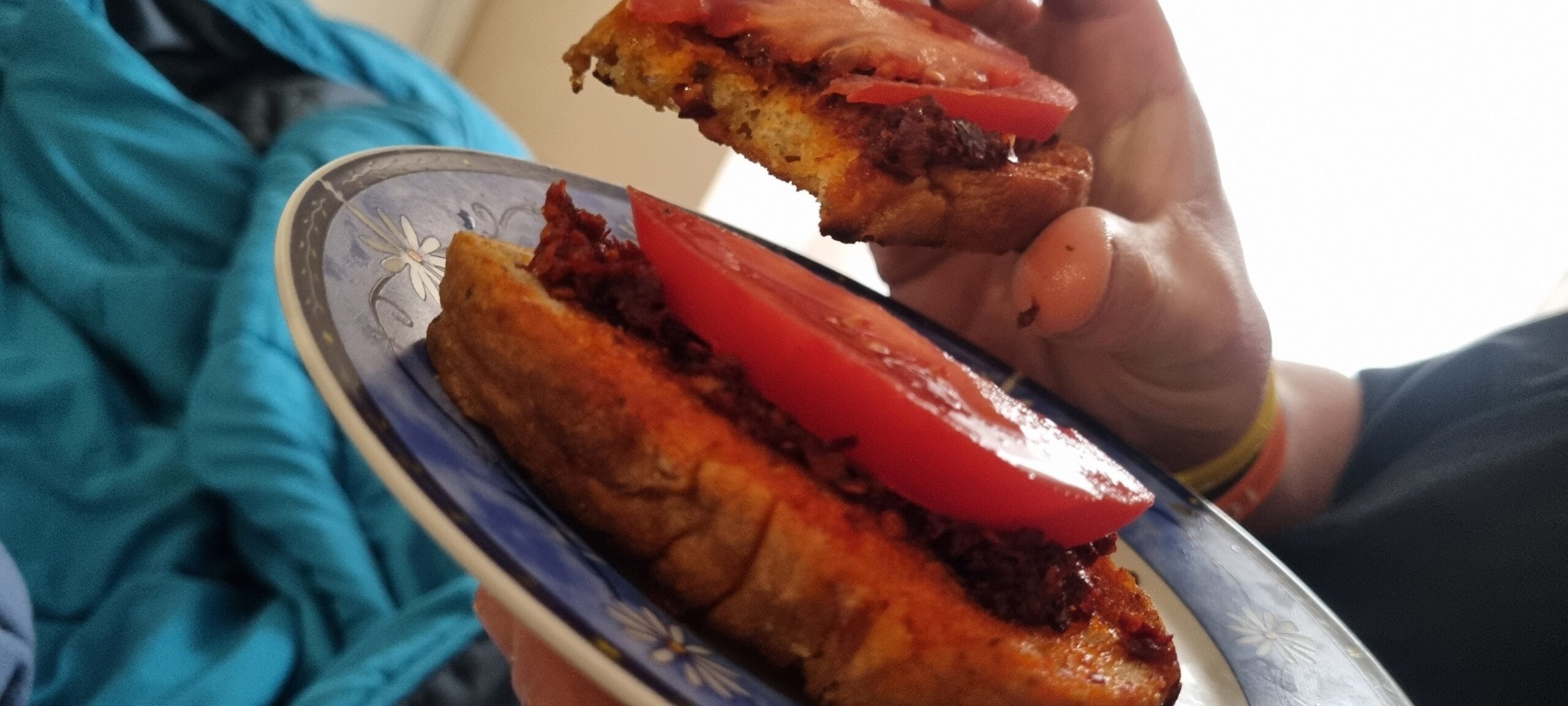
When you’re looking for local delicacies, just like the proverbial London buses, three come along at once…
If there’s one thing to try while wandering through Calabria (besides yet more Tropea onions or ‘nduja), it’s tartufo. Not the pricey mushroom kind—this is a gelato dessert. Although from its appearance you’d be forgiven for the mistake.
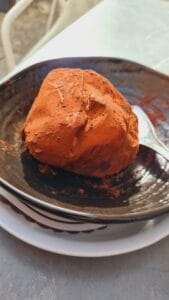
This glorious invention dates back to the 1950s, when a pastry chef in Pizzo, Dante Veronelli, found himself short on moulds during a wedding banquet. Ever the improviser, he hand-formed balls of gelato, stuffed them with molten chocolate, rolled them in cocoa and sugar, and—voilà!—the tartufo was born. It was an instant hit.
What is it, exactly?
A round, truffle-like ball of ice cream, usually with a soft, melty chocolate or hazelnut heart, encased in layers of hazelnut and chocolate gelato, then dusted with cocoa powder or chocolate shavings. Some versions are rolled in crushed nuts or finished with a liqueur drizzle. The centre oozes when you cut into it. Yes, it’s designed to be dramatic.
The name tartufo means “truffle” in Italian, and the resemblance is part of the charm. But unlike its fungal namesake, this one melts beautifully on your tongue and leaves you dreaming of seconds.
Like the onion it’s also protected: Tartufo di Pizzo has IGP status, meaning it’s regionally protected and must be made according to specific traditions, and—ideally—in Pizzo itself. It’s handmade in the best gelaterie, with recipes passed down for generations. It’s so iconic, the town of Pizzo is practically built around it—many cafés proudly display signs reading “Antica Gelateria del Tartufo.”
We didn’t make it to Pizzo, but found a very good gelateria in Tropea to try one of these special desserts at. It didn’t disappoint. If you’ve got a sweet tooth like me, then it’s a must when visiting.
Every year on 23 March, Tropea bursts into life with the Fiera dell’Annunziata, a cherished tradition that heralds the arrival of spring.
The day we were leaving Tropea… 23 March.
The day before we started to see various vans pull up near and outside our apartment. Then the taxi we booked to take us to the station in the morning told us the road would be closed, we would have to meet him up the road. Then the stalls started to be laid out. Hold on… there’s something going on here. A quick Google and we discovered all about the Fiera.
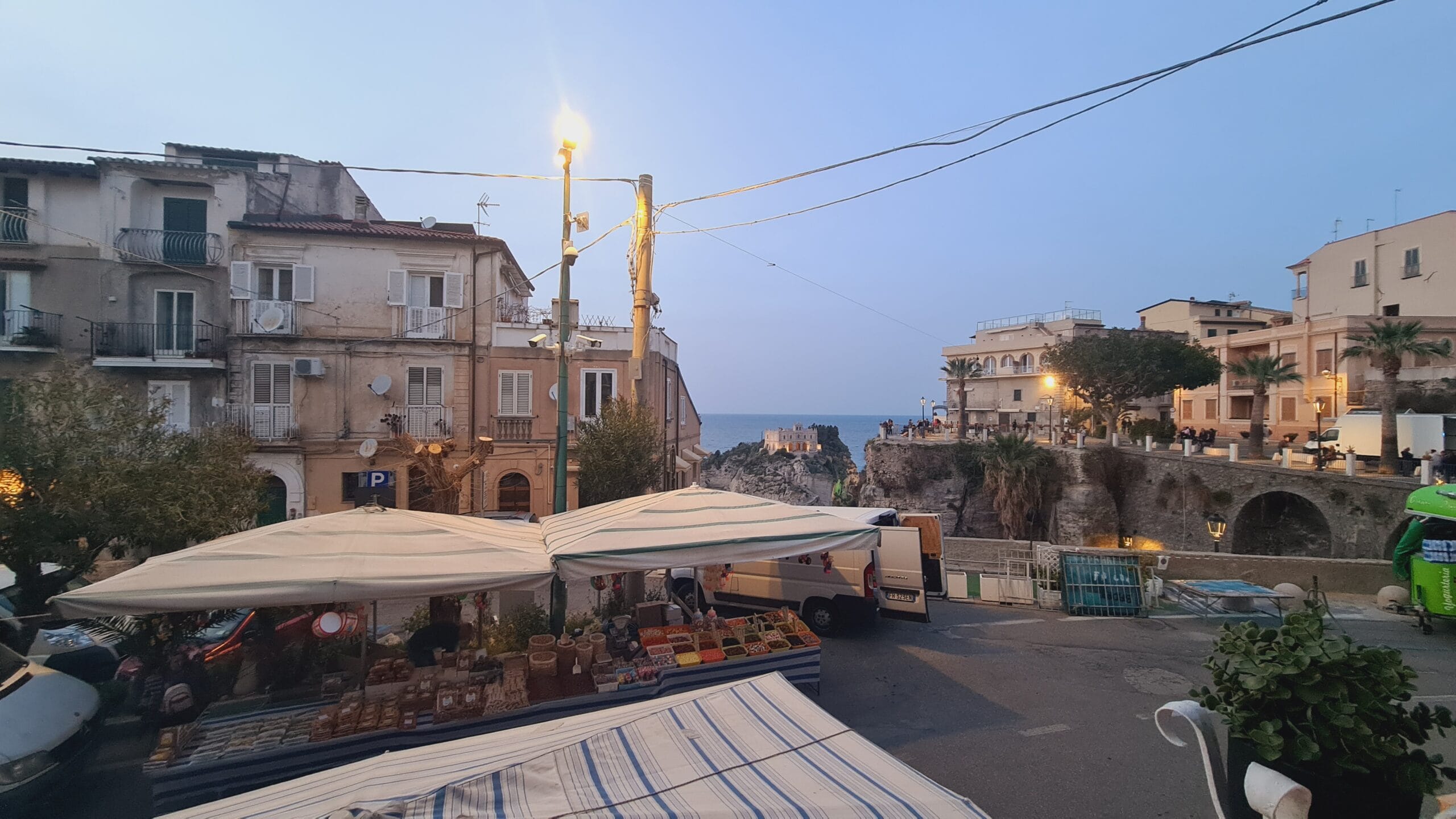
In equal measures, we were disappointed that we would miss it and fearful the party would start early and stop us from sleeping. After all, this fair isn’t just a shopping event; it’s a celebration of community and heritage.
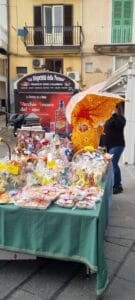 Fortunately, the loud generator running the candied nut stall right outside our apartment was turned off at 10pm and sleep we did. However, what we didn’t realise until checking out of the property was that our front steps had been turned into a stall. We literally had to step around packets of underwear and pyjamas to exit the property. Fortunately, we got out there before someone asked the price of a 3 pack of Y-fronts.
Fortunately, the loud generator running the candied nut stall right outside our apartment was turned off at 10pm and sleep we did. However, what we didn’t realise until checking out of the property was that our front steps had been turned into a stall. We literally had to step around packets of underwear and pyjamas to exit the property. Fortunately, we got out there before someone asked the price of a 3 pack of Y-fronts.
The entirety of Via Umberto I and Via Liberta were transformed into a bustling marketplace, echoing with the sounds of vendors and visitors chattering. The air was filled with the aroma of freshly candied nuts, baked goods and other local delicacies, creating an atmosphere that’s both festive and inviting.
What we found amazing was the variety of stalls on offer. Yes, local delicacies, flowers, baked goods, but also a light fitting stall, wallpaper, toys, kitchenware… literally, you could buy a kitchen sink!
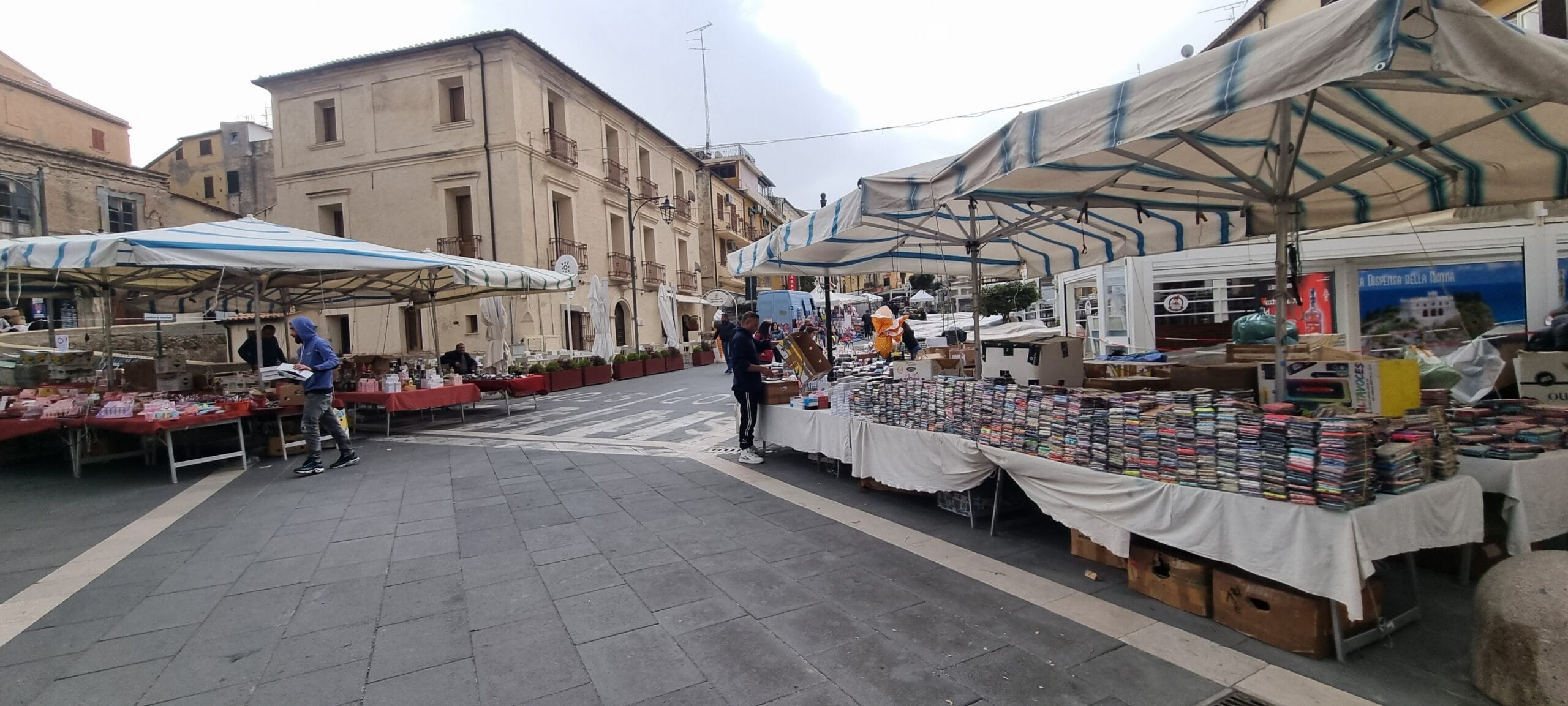
But beyond this bizarre bazaar, the Fiera dell’Annunziata is apparently a time for social connection and cultural expression. Street performers entertain passersby, musicians add a lively soundtrack to the day, and families come together to enjoy the vibrant scene. Although we only experienced the embryonic stages of the celebrations, it certainly felt like it was going to be a fun one.
As well as experiencing the Fiera in full swing, there’s another reason to return to Tropea: The Ulysses Sunset.
You know a sunset is special when it gets its own myth, photo contest, and name steeped in Homeric legend! Twice a year, along Calabria’s Costa degli Dei the sun doesn’t just set, it dives straight into the crater of Stromboli, one of the most active volcanoes in the world.
Locals call it the “Ulysses’ Sunset” (or Tramonto di Ulisse), in honour of the epic voyager who is said to have sailed these myth-rich waters. The idea is simple, yet breathtaking: for a brief window in spring and again in late summer, the alignment is just right, and from specific viewpoints along the coast—Tropea being a prime spot—you can watch the sun appear to sink directly into Stromboli’s smouldering silhouette.
It’s one of those rare natural spectacles that looks too cinematic to be real, like a slow-motion special effect performed by the universe itself. The light turns molten gold, the sea reflects a thousand firelit ripples, and the island-volcano glows on the horizon like a sleeping giant swallowing the sun whole.
We didn’t manage to catch it during our visit (a good excuse to return?), but as we saw on our first night, even the standard sunsets here are amazing—bold brushstrokes of orange, pink and violet, fading into the blues of the Tyrrhenian.
Tropea was supposed to be our first opportunity to really stop going at 100 mph, chill on the beach and not worry too much about a sightseeing checklist. The chill in the air didn’t allow for that, but we were warmed by some lovely Calabrian hospitality, the revelation of Tropea onions and the heat of the chilli in the ‘nduja.
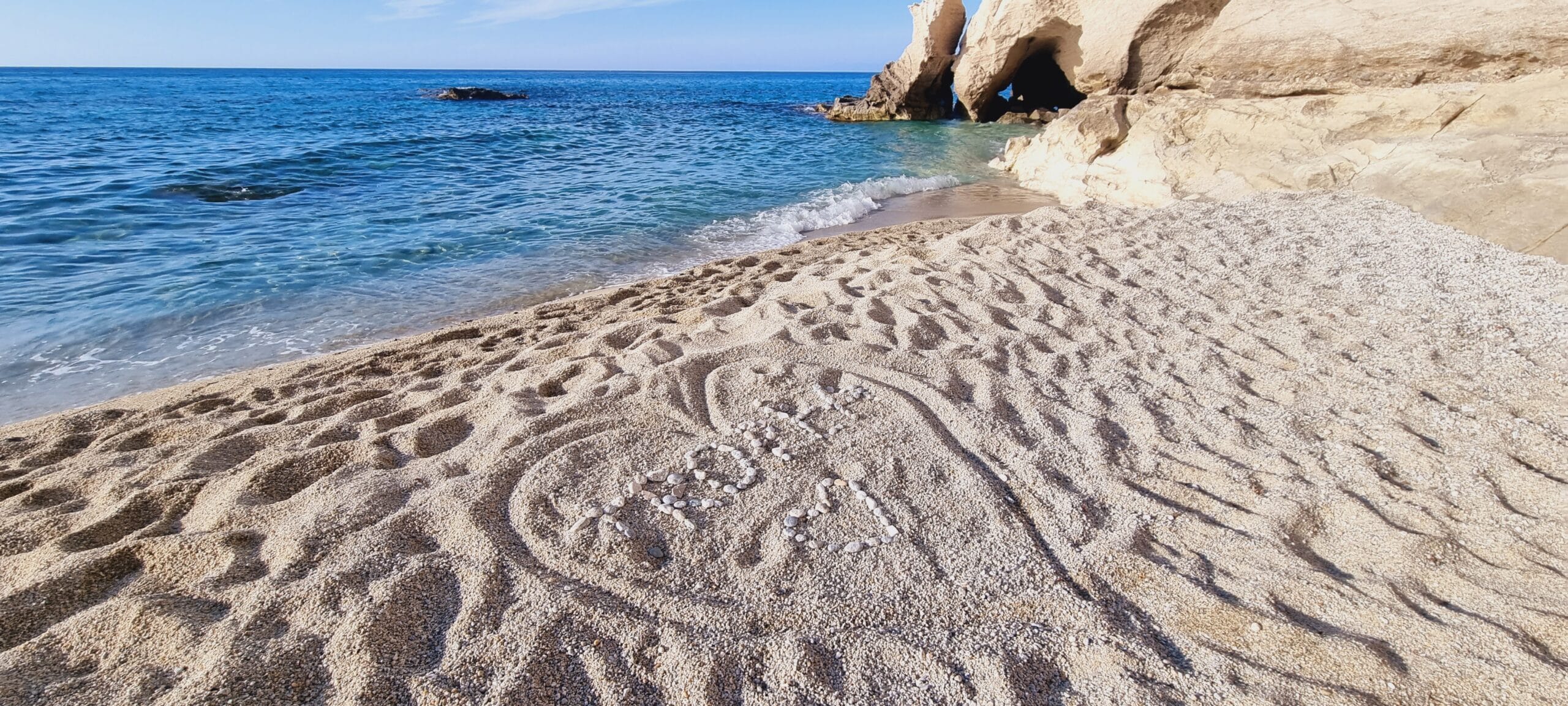
Follow us on instagram @a2z.wander

A2Z Wander | Our Blog A Rainy Arrival (and a Slight Hangover) Lamezia Terme almost didn’t get its own blog post. There’s only so many
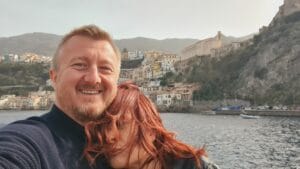
A2Z Wander | Our Blog A short coastal train ride punctuated by dramatic thunderclaps brought us further down into Calabria to a town called Scilla.

A2Z Wander | Our Blog Three weeks into the trip, and we were finally swapping wheels for waves, boarding our first boat along the coast

A2Z Wander | Our Blog With Sorrento in our rear-view mirror and the sea glittering to our right, we eased into the Amalfi Coast Drive,

A2Z Wander | Our Blog Naples left its indelible mark on us. We were sad to be leaving with so much still unexplored. But, if

A2Z Wander | Our Blog The heart of Naples beats in the Quartieri Spagnoli and its soul is painted on the walls. For our final